







When the pantry runs dry, these farmers step in
By Melanie Johnson For The St. Louis American
lack farming has been a way of life for Gibron Jones and his family since he was a 6-year-old boy growing up in North St. Louis. His mother and father picked and cooked food from the garden they started at their Walnut Park home near Goodfellow and Emma.
“I was blessed to have a family with humble poor beginnings,” Jones says. “The reason why we grew our food was because we couldn’t afford to spend money at the grocery store.”
Food insecurity and the lack of fresh food were struggles Jones saw his parents try to combat by giving away bags of produce to neighbors. The family’s garden included 75 tomato plants, berry bushes, lettuce, corn, squash, onions and more.
“I was out there trying to work the tiller as a kid, so to be doing this work now is a full-circle moment,” Jones says.
Across North St. Louis City and County, families face some of the most persistent food deserts in the See FARMERS, A12


By
Sylvester Brown Jr. St. Louis American
Houston-based healthcare company Nutex Health, Inc. says it will soon reopen the former medical facility on Jefferson that most recently operated as “Homer G. Phillips Memorial Hospital,” renaming it Archview ER and Hospital. The micro-hospital will offer 24/7 emergency and inpatient services, diagnostic imaging and clinical lab testing. The announcement marks the second attempt in two years to run a hospital inside the long-vacant building, a site whose name and history had previously sparked deep debate among residents and alumni of the original Homer G. Phillips Hospital in The Ville.
Archview will be Nutex’s first micro-hospital in Missouri. The physician-owned, publicly traded company operates more than two dozen micro-hospitals, specialty hospitals, outpatient departments and other facilities in 11 states. Karen Johnson, the facility’s chief nursing officer and former CEO of Homer G. Phillips Hospital, is leading the project.
See HOSPITAL, A13
Families get both at Urban League holiday drive
By Ashley Winters St. Louis American
Cars wrapped around the block outside the Urban League of Metropolitan St. Louis headquarters this week as volunteers handed out Thanksgiving meals. For many families, the drive-through line offered more than food — it offered reassurance. Hope. A reminder that someone still sees them.
President and CEO Michael P. McMillan stood amid the bustle, greeting volunteers who showed up in the hundreds on Tuesday.
“It always feels good to see so many people from the community come volunteer and help us,” he said, noting that the energy was as nourishing as the meals being boxed and loaded into waiting trunks.
The Urban League expects to serve more than 3,500 people this year, distributing more than $300,000 worth of food, toiletries and other resources across St.
See FOOD, A12
Black male educators bond while learning how to better serve their students Community brought them together
By Denise Clay-Murray
For The St. Louis American
When Darion Murdoch talks about the students he serves as principal of Flynn Park Elementary School in University City, his face lights up. He calls them his “babies,” and making sure they have what they need to thrive is his priority.
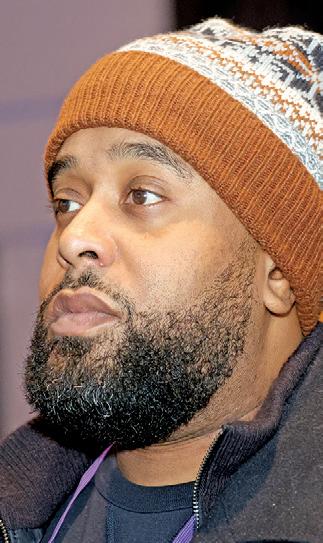
Murdoch grew up in the community where he now works, so he knows the value of seeing someone who shares your background in a leadership role. He’s also part of the 1.3% of the nation’s 3.8 million public school educators who are Black men, according to the National Center for Education Statistics. That means he does not always have colleagues who can relate to his experiences, he said. Last week, however, he was among more than 1,500 Black male teachers who spent three days in Philadelphia learning from one another, exchanging strategies and building community. Ian Buchanan, an educator and executive leadership coach, put the word out to Black male educators in the St. Louis region that he was organizing his annual trip to the Black Men in Education Convening, held Nov. 20-22.
See EDUCATORS,
The Ga people of Ghana, West Africa, begin a celebration in August that continues as a month-long thanksgiving known as Ga Homowo — the Harvest Festival. Many ethnic groups in Ghana and all over Africa have similar traditions.
Ceremonies and rituals vary, but the purpose is the same — remembering lean times, being thankful for present blessings and praying for future abundance.
There are no written documents to account for the origin of Homowo, but according to traditional stories, the Ga people emigrated from the Middle East and descended throughout the Sahara to Benin City in Nigeria. They settled there for a time before relocating to Accra, sometime between the 14th and 16th centuries.
Legends say the Ga had only a bit of corn and palm oil when they landed, which women ground and mixed together to make kpokpoi. After the men caught fish, the clan enjoyed their first meal after landing — kpokpoi and fish soup.
The immigrants planted millet and corn seeds they had brought with them. Then, they endured a long, lean waiting period while crops matured. When the harvest came, the Ga held a feast and gave thanks to their gods. The first celebration became the Hom Yi Womo, meaning a “hooting at hunger.”
In both sub-Saharan Africa and North America, the native people were mostly cooperative in the early days of European arrival. Nevertheless, conquest and colonization ensued later on both sides of the Atlantic.
Although some of us of African descent in this country now enjoy modest affluence, the overall status of our people must be defined largely in terms of the marginalized and less fortunate.That shared vulnerability became unmistakable this past year, when an unforgiving tornado swept through St. Louis and disrupted the lives of many of us and our neighbors.
So, we pause this Thanksgiving not only to remember those ancient harvest traditions, but also to give thanks for the extraordinary strength, unwavering community and will to survive that have defined our city in recent months.

Thanksgiving began in the United States in the 17th century as a celebration, a friendly coming-together of European settlers and the Indigenous people of North America. The Native Americans had welcomed the Pilgrims to this land and shared the vast knowledge they had about the continent’s flora and fauna. They explained planting corn and plowing and taught the newcomers trapping and fishing.
According to tradition, both peoples slaughtered turkeys, made dressing and had a version of cranberry sauce at the first Thanksgiving. They feasted together. During those tough early days for the newcomers, Native Americans extended their hands and opened their hearts. Their hospitality and support helped Europeans survive in an unfamiliar land.
We know of the bitter and bloody relationship that subsequently developed when conquest and colonization replaced the spirit of sharing and cooperation.
The vicious assault on Native Americans is not widely discussed anymore. The holiday has come to mean turkey and the trimmings, pre-Christmas sales and football. The history of the brutal process used by Europeans to dispossess the original people of their land is not pretty. And now it is almost completely ignored.
In Heart of Darkness, Joseph Conrad had Marlowe define the “conquest of the Earth” as “taking from those who have a different complexion or slightly flatter noses than ourselves.”
The May 16 tornado tore through North St. Louis, overwhelming neighborhoods that have anchored Black families for generations. Winds ripped roofs from homes, toppled brick walls, crushed cars and left entire blocks unrecognizable. Five lives were lost. More than 5,000 buildings were damaged or destroyed, with total losses estimated at $1.6 billion. In communities already strained by decades of disinvestment, the storm exposed how fragile basic safety has become.
Yet even before the dust settled, neighbors stepped forward. Within two days volunteers launched a community-organized effort known as The People’s Response, moving door to door with food, cleanup supplies and assistance for those hardest hit. The work showed what it looks like when people refuse to wait for systems that should have acted faster. We are thankful that, in the face of staggering loss, hope did not falter. That spirit of showing up for one another continues to guide the path toward rebuilding.
Our resilience was tested in other ways, too. Policy shifts in Washington rolled back diversity, equity and inclusion programs and froze or eliminated thousands of federal jobs. Black workers make up nearly one in five federal employees, so these cuts hit especially hard — particularly in agencies where Black staff form a large share of the workforce.
The 43-day government shutdown drove that reality home. As paychecks stopped and benefits were disrupted, families were reminded how close many households are to the edge. Black families experience food insecurity at more than twice the rate of white households, so any threat to SNAP benefits carried real consequences.
And so today we give thanks — for one another, for a resilience that rises even when storms and setbacks converge, and for the determination to keep rebuilding and renewing our communities, together.

By Frances Murphy Draper
On Nov. 14, 2025, aboard Air Force One, the President of the United States pointed at Bloomberg reporter Catherine Lucey and snapped, “Quiet. Quiet, piggy.” Why? She had the audacity to ask him a legitimate question about the Epstein files.
Days later, instead of apologizing, the White House defended him and implied that she somehow brought it on herself — that she was “inappropriate” and “unprofessional.”
So let’s be clear: Calling a woman “piggy” from the most powerful office in the world is abuse, not banter.
Suggesting she brought it on herself is classic abuser logic. And when the “CEO of the free world” behaves this way in front of cameras, he is not just expressing a personal opinion — he is modeling a pattern.
While October’s Domestic Violence Awareness Month has just passed, the deeper concern is not timing at all. It is the pattern. Rudeness is one thing; humiliation is another.
abuse, and women of color are targeted with a mix of gendered slurs and racist stereotypes.
So even when a specific slur isn’t explicitly racial, it sits inside a larger ecosystem of contempt for women and especially for women of color.
Studies of leader behavior and online discourse find that exposure to derogatory language from elites normalizes prejudice and harassment and that hate speech can spread through networks rapidly when it is modeled by those in power.
In other words, when the president calls a woman “piggy,” it doesn’t stay on the plane. It travels — into homes, social media feeds, school hallways, locker rooms, and workplaces.

Body-shaming is not politics. It is emotional violence.
Teen girls are already navigating brutal pressures. When they see the president call a woman “piggy” for doing her job, what are we teaching them? And what are we teaching our sons if we let this slide?
When pastors, principals, CEOs, editors, and community leaders say nothing, their silence sounds like approval.
In this particular incident, the reporter appears to be white. But we cannot pretend this moment exists in a vacuum. The same president has a long, documented history of calling women pigs, including calling Miss Universe winner Alicia Machado “Miss Piggy” and referring to Rosie O’Donnell as a “big, fat pig.”
And when you step back, a broader pattern comes into focus: Women who challenge him are “nasty,” “fat,” or “no longer a 10.”
Women of color who challenge him are often hit with both sexist and racialized language.
International research on women journalists confirms that sexism, racism, and other forms of hate often blend together in attacks — especially against women of color.
Reports from the UN Human Rights Office, ICFJ, and academic studies show that women journalists face disproportionately high levels of online and offline
We cannot tell women to report harassment and domestic violence out of one side of our mouths, while we excuse identical patterns of behavior from the most powerful man in the world out of the other.
This is the moment for all of us — parents, grandparents, teachers, pastors, coaches, mentors, journalists to acknowledge this language is abusive, demeaning and dangerous.
Speak up, publicly and privately, when leaders cross these lines. Not just when it’s politically convenient, but when it’s morally necessary.
Because if the president can call a woman “piggy” and blame her for it, and the country shrugs, then the problem is bigger than one man.
Dr. Frances Murphy Draper is CEO and publisher of The AFRO-American Newspapers.
By Ben Jealous
Americans aren’t just anxious about next year’s elections—they’re uneasy in a deeper way.
In 2025, voters across the political spectrum worry that our country is one overheated news cycle away from political violence.
At the same time, election officials are sounding alarms about something quieter but just as dangerous: there simply aren’t enough poll workers available to run our elections safely.
After years of threats, harassment, and burnout, thousands have walked away.
The people who keep democracy functioning are exhausted, and the voters they serve are fearful.
On the eve of our nation’s 250th birthday, we are heading toward an election cycle with a system that feels overstretched and overstressed.
In the fall of 1918, as the Spanish flu tore through Chicago, hospitals overflowed and neighborhoods fell under quarantine.
Yet the city refused to let democracy collapse. Officials rushed paper ballots to residents’ homes.
Yet this difficult moment offers something unexpected: clarity. Both political parties now see what they once resisted— that high turnout can help them.
Donald Trump proved that energizing unlikely voters can reshape the map.
Democrats have long understood that expanding access brings in voters who otherwise sit out.
Now Republicans know it, too.
Participation is no longer a partisan advantage.
It is a shared national opportunity.
That recognition makes this the hour for community leaders to rise together— so that when the 2026 legislative season arrives, our lawmakers are ready to shape elections that are simple, secure, and worthy of the nation’s 250th year.

Guest Columnist Ben Jealous
Nurses carried ballots to the sick; clerks delivered them to families behind closed doors. It was improvised and imperfect—but it worked.
Chicago proved something we need to remember now: when the ballot comes to the voter, democracy survives.
As America approaches its 250th year, we face a similar choice. Will we cling to systems that assume voters and poll workers will always be able to show up in person on the same day?
Or will we meet voters where they actually live—with a system designed for the pressures and possibilities of modern life?
Today, with election workers burning out and public confidence eroding, the fragility is showing.
A vote-at-home system is the clearest path to get there. A mailed-out ballot gives every voter the same chance to participate, whether they work a double shift, care for elders or children, lack transportation, or simply want the quiet time to study candidates without someone sighing behind them in line.
States like Colorado, Utah, and Oregon have shown that mailed ballots increase participation, build trust, and make elections easier to run and harder to disrupt.
Pennsylvania and Virginia now sit at the heart of whether the nation follows this path.
Pennsylvania’s no-excuse mail voting, adopted in 2019, remains uneven after years of lawsuits and conflicting rulings. If we want a democracy strong enough for the next 250 years, we must bring the ballot home—back to the kitchen table, where Americans make their best decisions.
Ben Jealous is a professor of practice at the University of Pennsylvania and former national president and CEO of the NAACP.
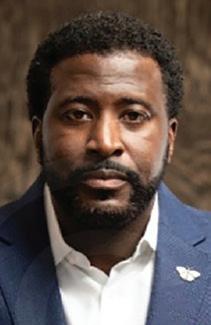
By Ashley Winters St. Louis American
When Shawn Jordan opened
Beauty Secrets Salon Studio, she quickly learned that launching a business took more than skill and ambition.
Like many new entrepreneurs, she stepped in because “everybody wanted to be a boss.” But once she got started, she realized she didn’t know how to run a business or reach the clients she hoped to serve.
“I had no clue what I was doing,” Jordan said.
But after going through Harris-Stowe State University’s Center of Innovation & Entrepreneurship (CIE), she felt she had a clearer sense of what she faced as a business owner.
“CIE helped me understand what I was doing and who my audience was,” Jordan said. “It gave meaning and purpose to my business and helped me raise the bar so clients feel comfortable walking in.”
The program supports underrepresented founders through training, mentorship, pitch preparation and access to professional networks.
As Small Business Saturday approaches on Nov. 29, CIE alumni like Jordan say community support is essential for staying open, growing and reinvesting in their neighborhood.
“Every purchase is supporting the inclusive community we want to build,” said Dr. Stacy Gee Hollins, associate provost and dean of the Anheuser-Busch School of Business. “When we support Black and Brown entrepreneurs, we invest in innovation, inclusion and opportunity
right here in St. Louis.”
The CIE has helped dozens of founders in industries ranging from food and beauty to retail, tech and consulting. Program leaders say the entrepreneurs drive the work — but it’s St. Louis residents who determine whether these ventures survive.
“These founders represent the power of possibility,” said Kristy Jackson, the CIE’s executive director. “Our role is to equip entrepreneurs with training and resources, but it’s the community that helps them stay open by shopping, sharing and supporting their work.”
For Jordan, that support means visibility and the resources to pay it forward.
“Shopping local helps me stay in business,” she said. “It lets me mentor young girls and show them how to carry themselves professionally. Being a small business gives me the financial means to be that mentor for them.”
Other CIE alumni said the program helped them navigate challenges that could have shut their businesses down.
Larry Johnson, owner of Deezl Distributing, said he didn’t realize how many resources were available to him until he joined the program.
“CIE helped me understand what support was out there and how to expand my business,” he said. Networking, he added, was especially critical when he struggled financially. “There’s strength in numbers. CIE gives us platforms to support small business owners and promote our businesses.”
Te’Ron Moore discovered his entrepreneurial spark in his

college dorm kitchen, where he cooked collard greens, fried chicken, cornbread and peach cobbler for friends. Staff encouraged him to turn his talent into a venture, which became Mojo’s Kitchen.
“It was a great experience,”
Moore said. “CIE helped with marketing, advertising — even teaching me how to do a 30-second pitch. They helped me get my LLC and helped me become a better businessman.”
Community support has opened doors for Moore beyond
Harris-Stowe State University’s Center of Innovation & Entrepreneurship provides training, mentorship, pitch preparation and professional networking for underrepresented entrepreneurs.
business transactions. He recently partnered with Feed the Streets STL to donate 200 meals.
“The community has always supported my goals and dreams,” he said. “That service gave me more exposure and keeps me motivated. Doing what I love gives a bright light to my brand.”
As Small Business Saturday nears, the entrepreneurs say the message is simple: shopping local keeps their doors open and their missions alive.
“It makes our businesses more visible,” Jordan said. “It lets the community know we’re here — and that we’re serving a purpose.”
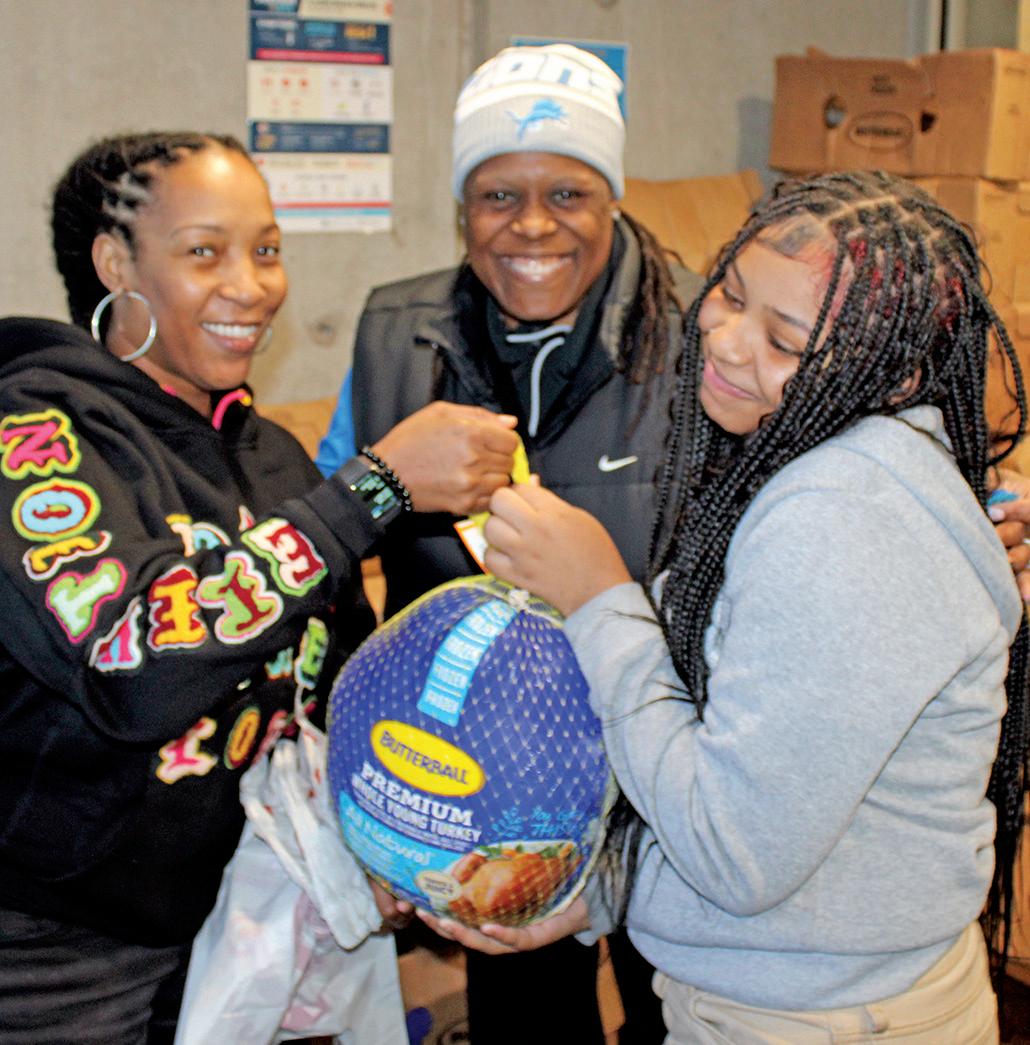
More than 200 area families received a free turkey in time for Thanksgiving at the Boys & Girls Clubs of Greater St. Louis’ Herbert Hoover Club on Friday, Nov. 21, thanks to former club members and NFL players Jameson Williams and Isaiah Williams.
Jameson Williams is a wide receiver with the Detroit Lions, and Isaiah Williams plays wide receiver for the New York Jets.
“Although Jameson and Isaiah are deep into their NFL season and were unable to attend in person, their mothers (Tiana Williams and Ashley Harris)
and a team of volunteers stepped in to ensure families felt their support,” said Herbert Hoover Club Director Reggie Williams.
“The players’ continued commitment to their hometown club reflects a long-standing bond with the community where they grew up and discovered their athletic talents,” he said.
Jameson Williams, now in his third season with the Lions, returns to the Herbert Hoover Club each year to host a youth football clinic for student athletes. He will play at 11 a.m. Thanksgiving Day when the Green Bay Packers visit Detroit.
By Julianne Malveaux
Every year, corporations expect us to line up, log on, and lose our minds for Black Friday. They expect us to stretch our budgets, drain our accounts, and pretend that “doorbuster deals” are some kind of patriotic ritual.
This year, a coalition led by the organizations Black Voters Matter, Indivisible, and Until Freedom is calling on us to do something radically simple—and profoundly powerful:
Enact a personal spending freeze from November 28 through December 1.
No Black Friday splurges. No retail rush. No “Buy Now” pressure. Why? Because we ain’t buying it—literally and figuratively.
Let’s start with the basics: Black consumers wield more than $1.7 trillion in annual spending power. Our dollars keep the retail economy humming. Our purchases shape markets, trends, strategies, and profits. Retailers depend on the holiday season to make their year—and they depend heavily on us.
tions like Amazon, Target, and Home Depot—not because they sell products we don’t want, but because they invest in politics we can’t accept. And they’re right to do it.
Let’s be honest—many of us overspend during this season. A freeze creates space to reassess:
• Do I need this, or am I being manipulated?
• Can these dollars go to a Blackowned business instead—after the freeze?
• Should I put this money toward savings, debt relief, or mutual aid?

So, when we withhold our dollars, even for four days, the impact is real. Corporations measure every hour, every transaction, every data point. They know exactly when consumers shift behavior— and why. A coordinated dip in spending during the biggest retail weekend of the year is not a whisper. It’s a shout.
If corporations can fund political agendas that hurt us, roll back inclusion with a smile, and pretend neutrality while siding with injustice, then we respond the only way they understand: with our wallets closed.
Black Voters Matter, Indivisible, and Until Freedom aren’t doing this for symbolism. They are doing it to apply economic pressure where moral pressure has failed. This is a coalition of organizers who understand history, power, and the long game. They are reminding us that protest isn’t only marches and petitions, sometimes it’s stillness, discipline, and withholding.
This coalition is calling out corpora-
A spending freeze also reframes the conversation around economic justice.
We’re not freezing spending because we’re angry shoppers.
We’re freezing spending because we’re informed citizens.
We aren’t punishing corporations. We’re educating them. If you undervalue Black consumers, if you undermine democracy, if you retreat from racial equity—then we have a moral obligation to respond.
Yes, we’re Angry - and we should be.
We’re angry that DEI has been reduced to a buzzword.
We’re angry that corporate leaders fold under political pressure.
We’re angry that Black communities still carry the highest costs—higher inflation, higher rents, higher interest rates—while being told to “celebrate savings” on cheap goods made overseas.
We’re angry that our political rights are under attack while corporations stay silent.
From November 28 through December 1, we close our wallets—and open our eyes. Not because we are powerless, but because we are powerful. Not because we are broke, but because we are strategic. Not because we are done fighting, but because we are just getting started.
Dr. Julianne Malveaux is a DC based economist and author.


By Shernay Williams Word in Black
History has already shown us that pulling our dollars hits harder than any speech, any march, any protest ever could,” says content creator Ashley B in an Instagram video. She’s part of a growing coalition of community organizers, pastors, and political engagement groups calling for a mass boycott ahead of the holiday retail season to flex Black political muscle and put economic pressure on corporations. The exact dates vary by group, but they all want a consumer blackout on the two biggest shopping days of the year: Black Friday, Nov. 28, and Cyber Monday, Dec. 1.
Considered the unofficial start of holiday shopping, both days generated roughly $30.8 billion in revenue last year, according to Adobe. Black Voters Matter, a nonprofit voting rights organization, is encouraging shoppers to avoid Target, Home Depot, and Amazon. Latosha Brown, the group’s cofounder, says the “We Ain’t Buying It” campaign targets these companies for “aligning themselves with policies and people that are seeking to harm us.”
Other organizations, like The People’s Union USA, want to expand the boycott to include all national chains, such as Macy’s, and major online retailers, including Shein and Temu. They want people to spend their dollars at small and local businesses instead.
“We gotta push back against this culture of fear that wants us to be paralyzed and feel a sense of hopelessness,” Brown says. “And make us forget that we have collective power.”
St. Louis entrepreneur builds business to close test-score gap
By Ashley Winters St. Louis American
Top Tutors for Us is a fast-growing St. Louis tutoring and test-prep company designed to help minority students achieve similar results.
Sometimes a personal hurdle becomes the moment that reveals the direction of a career. For Angelica Harris, that moment came the day she sat for the ACT as a junior at Christian Brothers College High School. Despite a straight-A record, she walked away with a 16 — far below what colleges and scholarships required. Determined not to let the score define her future, Harris built her own study system from scratch. Over months of practicing, analyzing mistakes and refining her strategy, she raised her score by 16 points to a 32. The jump unlocked more than $1.5 million in scholarship offers and helped her earn three degrees, including a master’s in computer science, from Washington University in St. Louis.
That transformation would later become the foundation of Top Tutors for Us, a fast-growing St. Louis tutoring and test-prep company designed to help minority students achieve similar results. What began as an effort to help local families has evolved into a structured academic support platform now partnering with major district and charter networks across the region.
“Fewer than 5% of Black students nationwide score above a 20 on the

Angelica Harris is founder and CEO of Top Tutors for Us, a St. Louis
and test-prep company that helps minority students improve college entrance
scores.
ACT,” Harris said. “Yet Missouri’s major scholarship programs require exactly that — if not higher. I saw firsthand how a test score can open or close the door to opportunity. And there wasn’t a test-prep program here created with minority students in mind.”
Top Tutors for Us now contracts with St. Louis Public Schools, Hazelwood, Maplewood Richmond Heights and multiple charter networks. Through these partnerships, students receive free, in-school tutoring and test preparation from tutors selected to reflect their interests, backgrounds and goals. Working across different school systems has confirmed a theme Harris said she sees everywhere she goes. “Students
Logan joins Thompson Burton as partner

Courtney Logan has joined Thompson Burton as a partner in the firm’s nationally recognized Direct Sales and MLM Practice Group. Logan advises companies operating at the intersection of business innovation and financial regulation. Based primarily in St. Louis, his practice includes business law, fintech, trading regulation, compliance and government relations.

Paraquad has appointed Latosha Fowlkes as its new chief executive officer. Fowlkes, a 2023 St. Louis American Foundation Salute to Excellence in Healthcare honoree, previously served as president and CEO of the Core Collective at St. Vincent. She is a licensed clinical social worker in Illinois and Missouri and brings more than 20 years of service and leadership experience.
Democratic U.S. Reps. Wesley Bell of Missouri and Hank Johnson of Georgia, along with U.S. Sen. Cory Booker of New Jersey, have introduced legislation that would allow workers and consumers to take racial discrimination claims to court rather than being limited to private arbitration.
The “Ending Forced Arbitration of Race Discrimination Act” would bar companies from requiring employees or customers to resolve racebased complaints through arbitration, a process critics say favors corporations and shields misconduct from public view.
Bell said people who experience discrimination deserve an opportunity to be heard in a public forum. “People who face racial discrimination deserve their day in court. They shouldn’t be pushed into a private process that
Continued from A5
across every district have big dreams. They just need access to the right support,” she said. “We help meet students exactly where they are and guide them toward where they want to go.”
Unlike traditional testprep services — some of which cost hundreds or thousands of dollars — Top Tutors for Us focuses on both the test and the academic gaps beneath it. Tutors rebuild math, reading and writing foundations before introducing ACT and SAT strategies. That approach reflects a broader challenge facing

was designed to protect corporations, not workers,” he said. He added that St. Louis residents know well “the consequences of sys-
districts nationwide.
“Many high schoolers are taking the ACT without mastery of middle school skills,” Harris said. “We start with assessments that identify those gaps so we can rebuild the fundamentals before teaching test strategies.”
The timing is critical. National ACT scores recently hit a 30-year low, with students in under-resourced communities facing some of the steepest setbacks. For minority students, the challenges compound: scholarship criteria often hinge on test scores, yet access to affordable, culturally responsive test prep remains limited. What differentiates Top Tutors for Us in a crowded tutoring market
tems that keep people from speaking out and seeking fair treatment.”
Booker said the measure is intended to ensure
is its matching system. Harris designed the program to pair students with tutors who share similar academic interests, career aspirations or cultural backgrounds. The company evaluates more than 50 factors when making matches.
That structure resonated with students like Mikayla Woods, a senior at Visitation Academy who turned to the program after an ACT result she wasn’t satisfied with.
“After my sessions, I had more confidence in myself,” Woods said. “I took a lot of practice tests, and I felt comfortable asking questions when I wasn’t sure about something.” What made the biggest difference, she

U.S. Rep. Wesley Bell has joined U.S. Rep. Hank Johnson and Sen. Cory Booker in introducing a bill that would let workers and consumers take race discrimination claims to court.
equal access to justice.
“No one who has faced discrimination because of their race should lose their right to seek justice
said, was seeing tutors who reflected her own experiences. “They looked like me. They understood where I was coming from. It feels like a tight-knit community.”
Representation remains a national shortage.
According to “Trends in Volunteer Mentoring in the United States,” only about 15% of volunteer mentors and tutors are Black — a gap that affects academic outcomes and student confidence.
Harris emphasizes that two obstacles families face are cost and time. High-quality test prep is expensive, putting it out of reach for many. Families also struggle to attend after-school sessions when students work jobs, care
simply because they were forced to sign an arbitration agreement,” he said.
“This is a long-overdue change in the law that will
for siblings or face transportation challenges.
District contracts eliminate those barriers by offering the program free for participating students and embedding tutoring during the school day, which increases consistency and reduces absences.
On its website and in its business materials, the company positions itself as more than a tutoring service — it’s a holistic academic pipeline designed to support students from elementary school through college admissions.
Harris sees long-term growth in expanding beyond ACT and SAT prep into broader tutoring, enrichment programs, college-readiness pathways and even graduate exam
empower workers and others to fight back against mistreatment and achieve equality.”
Johnson called the bill an overdue extension of protections Congress has granted in other areas. “Everyone deserves the right to choose between court and arbitration,” he said.
Dozens of civil rights and legal advocacy organizations are backing the proposal, including the National Urban League, the National Fair Housing Alliance, the National Center for Law and Economic Justice, and the Leadership Conference on Civil and Human Rights.
Linda Lipsen, CEO of the American Association for Justice, praised the bill, saying, “Forced arbitration is a secretive and rigged system that too often allows race discrimination to continue relentlessly.”
preparation.
“I want students supported at every stage — from state assessments and private school admissions tests to the ACT, SAT and even graduate exams,” she said. “Test scores matter, but so does confidence and seeing yourself reflected in your educators.”
Her goal is to build a complete K-College academic ecosystem serving St. Louis, one that narrows opportunity gaps and expands access to competitive scholarships and selective institutions.
“Ultimately, we want to be the go-to resource for closing opportunity gaps and opening doors,” Harris said. “Every student deserves the chance to thrive.”


lack people know intrinsically about the myriad of life areas negatively impacted by the fact that the myth of white supremacy is baked into the foundations of all American institutions. But one area that doesn’t get enough attention is how racism robs Blacks of one of nature’s most powerful healing agents – sleep. Blacks have disproportionately higher rates of sleep disorders (sleep apnea, insomnia, more light and less deep sleep, delayed onset, more daytime sleepiness, and shorter sleep duration) compared to any other racial and ethnic groups in the U.S. These disparities are compounded by the fact that they contribute to additional racial health disparities.

Historically, sleep has been elusive for African Americans. From being shackled together en masse in the bowels of a slave ship, lying down, side-by-side, head to foot or even closer, with very little airflow and extremely unsanitary conditions, to living in tight quarters on a plantation, being worked from “sun up to sun down,” fear and terror, to the belief that African people “require less sleep,” African Americans have a long history of sleep deprivation and disruption. Unfortunately, the consequences of a history of structural and systemic racism on sleep and sleep-related health outcomes are relatively unknown.
– Dr. Karen Lincoln
Advocates
By Ashley Winters
St. Louis American
Black women in Missouri are 2.5 times more likely to die from pregnancy-related complications than white women — a stark reminder that where and to whom you’re born can still determine whether you survive motherhood. Behind those numbers are mothers, babies and families forever changed by a crisis health leaders say should not exist.
Generate Health, a local multiracial coalition, is trying to close that gap with its new #2BHeard campaign. Inspired by the Centers for Disease Control and Prevention’s “Hear Her” initiative, #2BHeard aims to raise awareness about urgent maternal warning signs and help women advocate for themselves before, during and after pregnancy.
“We envision a future where Black
families in St. Louis thrive before, during, and beyond pregnancy,” said Lora Gulley, Chief Operating Officer of Generate Health. “Yet Missouri continues to be one of the most challenging places in the See MATERNAL, A8
See SLEEP, page A8
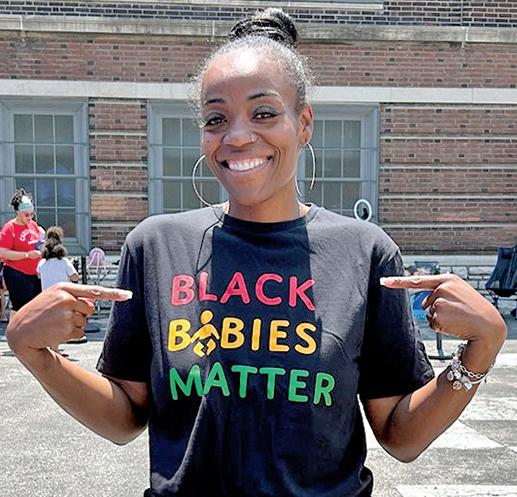
sleep. 43.5% of Blacks had trouble sleeping
The problem is that we just don’t know how much these disparities in sleep disorders impact other negative health outcomes because Blacks, whether by circumstance or design, are grossly underrepresented in clinical trials.
For example, evidence strongly suggests that poor sleep quality adds to the potential to later experience Alzheimer’s disease (AD) and related dementias. However, because Blacks are nearly invisible in AD trials, the medical community’s understanding of the impact of poor sleep is based on samples of white people.
By the numbers
• Black people are consistently less likely to get 7 hours of sleep a day compared with their white counterparts and other people of color.
• More than 41% of Black individuals were not getting enough sleep in 2018, versus 31% of white participants.
(Yale School of Medicine 2022 published research)
34.8% of all U.S. adults revealed that they were not getting enough
Continued from A7
Continued from A7 nation for maternal health.
30.7% of whites had trouble sleeping (CDC 2020 national survey of more than 400,000 Americans)
Loss of sleep makes us less happy and more anxious
A recent study led by University of Houston Professor of Psychology Candice Alfano reiterates the fact that losing sleep is actually something to lose sleep about.
The loss of sleep, again, something that disproportionately impacts Blackfolk, doesn’t just make us tired – it can increase anxiety, degrade mood, and altogether undermine our emotional well-being.
The study, for which Alfano was the senior author, published by the American Psychological Association in the journal Psychological Bulletin, synthesized more than 50 years of research on sleep deprivation and mood.
Courtesy Family Means
“Emotions govern virtually every aspect of our daily lives, and depriving ourselves of sleep seems to be a sure way to elect a terrible governor. Our findings confirm that even when sleep is only mildly deficient, there are measur-
Eighty percent of these deaths are preventable. This isn’t just data — it represents mothers, babies, and families forever impacted.”
The campaign’s goal is to ensure pregnant and postpartum people, their support systems and their providers recognize when something is wrong and act quickly. Gulley said #2BHeard is building deeper community engagement, stronger clinical
able negative changes in how we react to everyday events,” reports Alfano, who is also director of the Sleep and Anxiety Center of Houston.
Co-authors of the report include Cara Palmer and Joanne Bower, two of Alfano’s colleagues.
“In our largely sleep-deprived society, quantifying the effects of sleep loss on emotion is critical for promoting psychological health,” said Palmer, an assistant professor at Montana State University. “This study represents the most comprehensive synthesis of experimental sleep and emotion research to date, and provides strong evidence that periods of extended wakefulness, shortened sleep duration, and nighttime awakenings adversely influence human emotional functioning.”
The team analyzed data from 154 studies spanning five decades, with 5,715 total participants. In all those studies, researchers disrupted participants’ sleep for one or more nights. In some experiments, participants were kept awake for an extended period. In others, they were allowed a shorter-than-typical amount of sleep, and in others they were periodically awakened throughout the night. Each study also measured at least one emotion-relat-
partnerships and a culture where Black women’s voices are not only heard but valued.
ed variable after the sleep manipulation, such as participants’ self-reported mood, their response to emotional stimuli, and measures of depression and anxiety symptoms.
Overall, the researchers found that all three types of sleep loss resulted in fewer positive emotions such as joy, happiness, and contentment among participants, as well as increased anxiety symptoms such as a rapid heart rate and increased worrying.
“This occurred even after short periods of sleep loss, like staying up an hour or two later than usual or after losing just a few hours of sleep,” Palmer said. “We also found that sleep loss increased anxiety symptoms and blunted arousal in response to emotional stimuli.” Findings for symptoms of depression were smaller and less consistent. The findings were also more mixed for negative emotions such as sadness, worry, and stress.
“Research has found that more than 30% of adults and up to 90% of teens don’t get enough sleep,” Palmer said. “The implications of this research for individual and public health are considerable in a largely sleep-deprived society. Industries and sectors prone to sleep loss, such as first responders, pilots,
Despite years of advocacy, Black mothers in St. Louis still face inequities deeply rooted in the health care system. Gulley cited racism, bias and a lack of accountability in the systems that shape women’s health.

and truck drivers, should develop and adopt policies that prioritize sleep to mitigate against the risks to daytime function and well-being.”
Historically, Black sleep deprivation is often ignored
However, the study examined both age and sex as moderators of emotional outcomes, not race, even though Blacks are historically more deprived of sleep.
Researchers state that “directions for future research” could include looking at individual differences to find out why some people may be more vulnerable than others to the effects of sleep loss, and examining the effects of sleep loss across different cultures, as most of the research in the current study was conducted in the U.S. and Europe, according to the researchers.
But the Black community is cautioned not to hold its breath waiting.
“Historically, sleep has been elusive for African Americans. From being shackled together en masse in the bowels of a slave ship, lying down, side-by-side, head to foot or even closer, with very little airflow and extremely unsanitary conditions, to living in tight quarters on a plantation, being
“The data speaks for itself,” Gulley said. “Too often, Black women are not believed when they speak up about their symptoms or concerns, and bias in care can delay or deny lifesaving support.”
Doula and OB-GYN nurse Tannelle Hanks sees that disconnect play out in exam rooms and delivery suites. She said one of the biggest problems is health care providers are simply not listening.
“Providers miss urgent warning signs because they’re not taking patients seriously,” Hanks said. “Education can prevent these oversights. When we educate mothers prenatally and postpartum, we can prevent so many of these deaths.”
Sandra Thornhill, a doula and vice president of Jamaa Birth Village in Ferguson, said the crisis begins with the narratives imposed on Black women.
“For generations, the dominant narrative has focused on negative outcomes in Black bodies, which leads people — even Black birthing people themselves — to internalize the idea that something is inherently wrong with them,” she said. “But the truth is, the problem isn’t us. The real solutions have to come from the institutions that created these outcomes in the first place.”
Thornhill points to historic and current policies that continue to shape poor maternal outcomes.
“Our bodies have never been the issue,” she said. Her work as a doula grew out of what she witnessed in delivery rooms.
“Historic racism shows up in birthing spaces that are supposed to be places of care and safety,” she said. “We’re not seen as fully human, as people who deserve comfort, attention, and responsive care.”
Hanks said the issue extends beyond individual providers.
“The whole concept of systemic racism plays a role in every part of the health system,” she said. “Everything from private pay to lower-income patients is affected. Sometimes our hands are tied because of the insur-
worked from “sun up to sun down,” fear and terror, to the belief that African people “require less sleep,” African Americans have a long history of sleep deprivation and disruption,” wrote Karen Lincoln, PhD, UCI professor of environmental and occupational health. “Unfortunately, the consequences of a history of structural and systemic racism on sleep and sleep-related health outcomes are relatively unknown.”
And Lincoln says Black sleep issues are not merely a thing of the past.
“Today, African Americans face different circumstances but are still impacted by poor sleep and subsequent health disparities. Sleep tends to be socially patterned – we often observe poor, disrupted, and irregular sleep patterns among those in lower socioeconomic positions, including shift work and long hours which contribute to chaotic and irregular sleeping conditions. African Americans are often concentrated in low-skilled and low-paying jobs, with very little control and flexibility in their schedules. The effects of noise, light, traffic, crime, and discrimination – which are socially patterned by neighborhood – on sleep outcomes have been well documented,” said Lincoln.

ance and the care we’re allowed to provide.”
Still, she said, providers can help families connect with resources.
“It’s up to us to help families find resources — housing, healthy food options, wrap-around services,” she said. “Policies should allow healthcare workers to do more.”
Gulley said improving outcomes starts with listening.
“When we listen to women, address racism in care, and ensure every mother has access to informed, respectful, culturally centered support, outcomes improve for everyone,” she said.
Storytelling is central to #2BHeard.
“Every story shared through #2BHeard reinforces that mothers are experts in their own experience,” Gulley said. “When they say, ‘I didn’t feel heard,’ that’s a call to act.”
Those stories guide Generate Health’s advocacy. The organization also pushes to expand access to doulas, midwives and community health workers, who can help bridge gaps between families and medical systems.
“Storytelling turns pain into purpose,” Gulley said. “It becomes a bridge between policy and lived reality, driving empathy, accountability, and reform.”
At Jamaa Birth Village, Thornhill said, the care starts with seeing mothers as whole people.
“When a mother walks through our doors, she’s our sister,” she said. “We
walk with families during pregnancy, birth and postpartum.”
Missouri’s 2023 decision to extend postpartum Medicaid coverage from 60 days to 12 months has also helped, Hanks said.
“Many moms and babies are dying in those early months,” she said.
“Now we finally have the time to partner with mothers during that first year.” Gulley said progress will depend on transforming how systems value Black women’s voices.
“We need to transform the way we listen, care, and respond,” she said.
“That means expanding doulas, midwives, and community health workers, training providers to recognize urgent warning signs, increasing trauma-informed care, and advancing policies like paid leave and doula reimbursement.”
Decades of inequity have eroded trust between Black women and the health care system — a reality #2BHeard is trying to repair. By creating spaces for mothers to share their truth, Generate Health is working to foster understanding across hospitals, clinics and community organizations.
“Trust grows when voices are respected and acted on,” Gulley said.
“We’re not only raising awareness — we’re building shared understanding, fostering empathy, and strengthening relationships across systems. Our message is simple: listen first, believe women, and respond with action.”
Time co-founder
Jellybean Johnson passes at 69

Jellybean Johnson, the Minneapolis music icon and founding member of Prince’s band The Time, has died at age 69. Loved ones say Johnson, whose real name was Garry George Johnson, passed suddenly on the evening of Friday, Nov. 21—just two days after celebrating his birthday.
“The family of Jellybean Johnson is deeply saddened by the passing of their beloved husband and father,” his family said in a statement. “Jellybean was an innovator of what became known across the world as the Minneapolis Sound. Jellybean loved his family, his friends, and the city of Minneapolis.”
Pras sentenced to 14 years in prison
Fugees member Pras Michél has been sentenced to 14 years in prison after he was convicted on charges of conspiracy and illegal foreign lobbying.
According to Variety.com, a judge sentenced Michél on Thursday after he was convicted in April 2023 on 10 counts. They include violating campaign finance laws during Barack Obama’s 2012 reelection bid and illegally lobbying the Donald Trump administration in 2017. According to Billboard.com reported that Michél was handed a 14-year sentence, which will be followed by three years of probation. He was facing 22 years behind bars.
privacy, grace, and understanding as we navigate this transition with our family.” Burruss, 49, and her producer husband Tucker, 52, met while filming the fourth season of “The Real Housewives of Atlanta” in 2011. They announced their engagement in January 2013, and exchanged nuptials in April of the following year.
Longtime collaborator Bryan-Michael Cox named in Usher lawsuit
Usher is suing one of his longtime music producers, other associates and their attorney over a loan he says he gave them for a Buckhead restaurant that never opened. According to WSBTV.com, Usher Raymond filed the lawsuit in Fulton County on Friday against Bryan-Michael Cox, Keith Thomas, Charles and entertainment lawyer Alcide Cox has produced some of Usher’s biggest hits, including “Burn” and “U Got It Bad.” Thomas and Hughes also work in the entertainment industry.

Following the sentencing, Michél’s attorney Peter Zeidenberg described the 14-year sentence as “completely disproportionate to the offense.” He noted that such lengthy terms are typically reserved for violent criminals or high-level drug cartel leaders.
Kandi Burruss files for divorce
Kandi Burruss and Todd Tucker are going their separate ways after 11 years of marriage.
“After deep thought and a lot of prayer, I’ve made the decision to move forward with a divorce,” Burruss told PEOPLE.com in a statement. “This is a difficult and emotional time, but my focus remains on protecting my peace, being the best mother I can be, and co-parenting with love and respect.”
In the statement, Burruss said that she is “stepping into a new chapter” pouring into her work, family and personal growth.
“I’m grateful to everyone who supported us throughout the years,” the statement said. “I ask for
Usher says the group came to him last year with the idea to open a restaurant and lounge called Homage ATL. The singer did not want to be an investor, but agreed to loan the group $1.7 million and wired it to a trust account in January, according to the lawsuit.
He received $1 million in August, but said he hasn’t received the remaining balance of $700,000. Usher’s lawsuit accuses Honoré of admitting that giving the money back was “not that easy” because it had been used for “other purposes.”
The lawsuit requests $4.9 million in damages, $700,000 for each of the seven claims in the lawsuit.
Cox responded to the suit with an Instagram post.
“I’ve learned a lot recently about being careful with who you choose to invest in a business with, no matter how small the investment,” Cox said in the caption of a photo of him and Usher.
“I’m currently in the middle of a failed deal that I didn’t orchestrate, and while the situation has been disappointing, I know my name will be cleared by both sides. While I’m unable to share more details right now, I want to make one thing absolutely clear: my 27-year friendship with Usher remains fully intact.
Sources: ABCNews.com, Billboard.com, Fox5atlanta. com, Variety.com, WSBTV.com, Instagram.com



















The St. Louis American’s award winning
The St. Louis American’s award winning NIE program provides newspapers and resources to more than 8,000 teachers and students each week throughout the school year, at no charge.
program provides newspapers and resources to more than 8,000 teachers and students each week throughout the school year, at no charge.
Questions or comments? Contact Cathy Sewell csewell@stlamerican.com or 618-910-9551


Students

Nikki Binion’s 3rd grade class at Jackson Park Elementary School attempt to
Students at The American’s Summer Science Academy work in teams to discover the many different computer programming languages.



A hurricane forms over tropical and subtropical ocean water. Warm water and cool, moist air combine to create strong winds that can gust up to 200 miles per hour! These winds create waves that bring the storm on shore. Hurricanes are very destructive. They can flip cars, sink boats, uproot trees, and demolish houses.
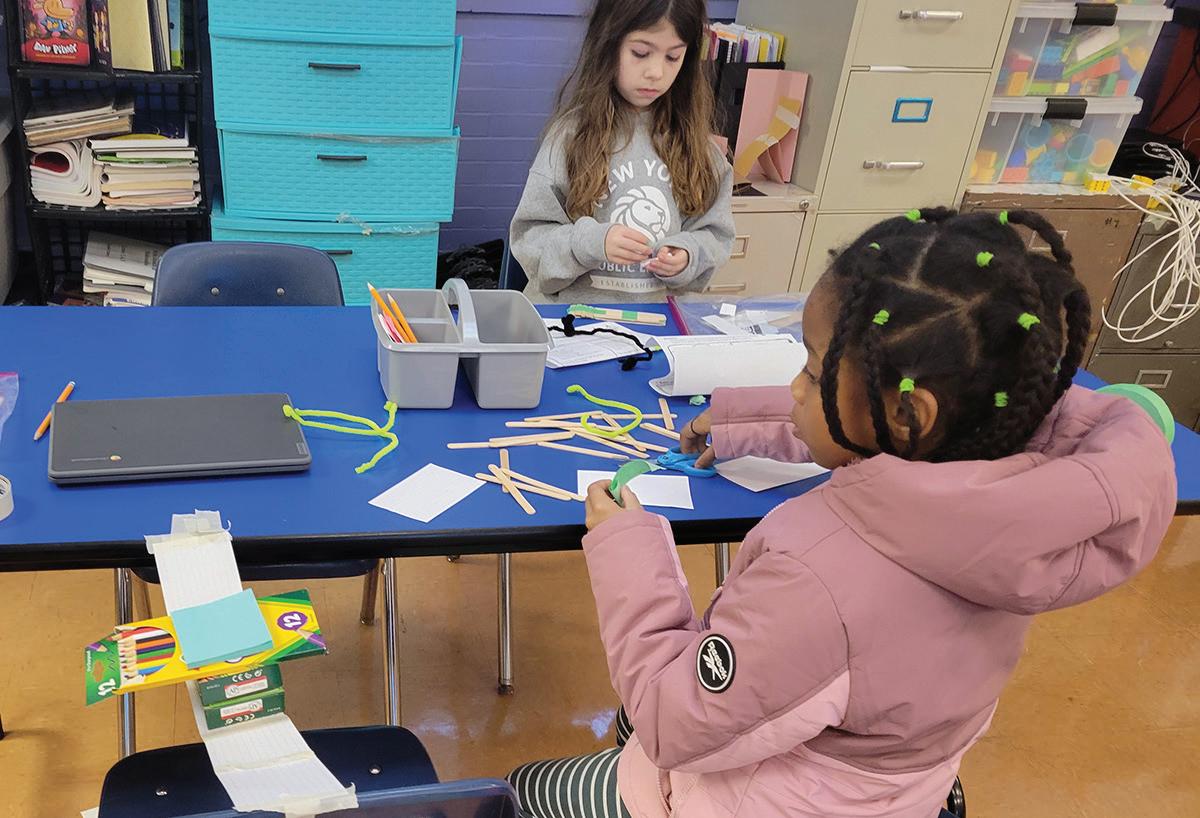




In addition to powerful winds, hurricanes bring a lot of rain. (Taiwan received 114 inches of rain in three days during a hurricane.) These rains can cause landslides and flash floods.


Scientists in this field study the conservation and management of wildlife and fish. They evaluate the environment and habits of these animals, allowing the scientists to understand disease, habitat, and behavior. For example, studying the eating habits of a type of fish will help the scientists determine if the area has enough food supply to support their population. These biologists help control population when it is overgrown and help to replenish endangered species. They help keep water clean and safe. Studying how fish respond to diseases not only helps that species of fish, but that information is also helpful to learning how humans could possibly respond to treatments for diseases.
Fungi are organisms made of filaments (called hyphe) that are stacked together. Unlike plants, fungi do not have chlorophyll, so they cannot make their own food. Some fungi are parasites, which mean they live off of other organisms. Some fungi feed off of dead and decaying matter. Fungi are everywhere in the environment, including the soil, lakes, river and seas, air, and fungus) help organic matter to decay and release carbon and oxygen into the environment. Unlike plants, fungi do not have
In this experiment, you’ll create a replica of a hurricane and identify how the forces work together to create a hurricane.
Materials Needed:
Materials Needed:
Hurricanes can last a few hours or several days. Most hurricanes occur during the fall months. How can you stay safe? Have an evacuation plan and an emergency kit prepared. Meteorologists can track these storms and keep you informed. For more hurricane facts, visit: http://www.sciencekids.co.nz/ sciencefacts/weather/hurricane.html.
leaves, stems, or roots. Fungi use spores to reproduce. One common type of fungus is the mushrooms you find on your pizza. Mold, yeasts, and mildew are also types of fungus.
To have a career in this field, you will need a bachelor’s or a master’s degree. This field offers many types of job choices. You can work on boats to collect information for research. You can work in fields or streams. You can work in a lab, and you can be a teacher or professor for this field.
Learning Standards: I can read nonfiction text for main idea and supporting details.
For More Information, Go to: https://kids.kiddle.co/Fungus
Learning Standards: I can read nonfiction text for main idea and supporting details. I can make text-totext and text-to-world connections.
Your Own Hurricane!
Learning Standards: I can read nonfiction text to gain background information about fungi.

• Small Paper Cups or an Ice Cube Tray
• 2 Soda Bottles • 3 Paper Clips
• 3 Peanuts • ¼ C. Sand • Funnel
create a watertight seal. Continue taping 1 to 2 inches above and below the seam.
In this experiment, you will create a setting for ice fishing.
• Water • Duct Tape
• Glass or Bowl of Water • String (yarn or kite string works great) • Small Stick (this will be your fishing pole) • Salt
Procedure:
Procedure:
Materials Needed:
q Fill the cups or tray with water and place in the freezer.
• 3 slices of bread • Water • 3 Ziploc bags
q Fill one bottle with the paperclips, peanuts and sand. These represent the debris and help make the movement of water easier to see.
• 10x10 square centimeter grid • Ruler
Process:
w Place the funnel in the mouth of the bottle and pour water into the bottle until it is 3/4 full, then remove the funnel.
w When the water is frozen, remove the ice from the cup or tray.
q Wet one slice of bread enough to make it moist and place it in a bag. Seal the bag very tightly.
e Turn the second empty bottle upside down and hold it over the first bottle so that the mouths of the bottle are aligned. The bottles will look like an hourglass.
z
e Put the ice in the glass or bowl that has been filled with water.. The cube will bob up and down in the water before it floats to the top.
w Place the two other slices of dry bread in two separate bags and seal them, as well.
r Place one end of the string from the fishing pole on top of the ice cube and
r Tape the seam, pressing the duct tape firmly to
e Place the bag with the wet slice of bread and one of the bags with a dry slice of bread in a dark place, such as a closed cabinet or closet. Place the third bag with a dry slice


Solve these fish-related word problems.

sprinkle salt on the ice where the string is touching. The water will melt and refreeze.
t Hold the bottles by the middle and lift the jugs.
In this experiment, you will learn how mold grows best. Mold is an important fungus that has several uses, including breaking down dead organic material. Some purified molds are actually used as an antibiotic to treat illnesses.
t After about 10 seconds, carefully lift the ice cube out of the water with the fishing pole. You caught a fish (ice)!





William (Bill) Parker grew up in New Orleans. He graduated from JFK High School, which focused on math, science, and engineering. Parker was interested in hurricanes at a young age, but he became interested in the weather after a high school statistics class. In this class, he learned how to predict the chance of rain. Parker wanted to attend a historically black college/ university (HBCU), so he chose Jackson State University to study meteorology. He graduated with his bachelor’s degree, in 1994.
Jeanette Jones was born on September 19, 1950, in Fort Valley, Georgia. Jones graduated from Fort Valley State University in 1972 with a bachelor’s degree in biology education. In 1973, Jones received her master’s degree in botany and mycology (a branch of biology that studies fungi) from The Ohio State University. In 1976, she received her doctorate (Ph.D.) degree.
She also studied at the University of Nevada, the University of California Medical School, the National Center for Disease Control-Atlanta, and the Massachusetts Institute of Technology. After graduation, Alabama A&M University hired Jones as an assistant biology professor. In 1986, she served as an adjunct professor in the College of Pharmacy and Pharmaceutical Services at Florida Agricultural and Mechanical University and worked on a project with NASA. In 1991, Jones served as the first female vice president of research and development at Alabama A&M University. She also served as President of Alabama A&M University’s Faculty Senate from 2001 to 2006. In 1992, she was appointed to the U.S. Army Science Board by the U.S. Secretary of the Army, Togo West. Since 2004 Jones has been the director of the Center for Biomedical, Behavioral, and Environment Research at Alabama A&M University. She also worked as a consultant with federal agencies to help them develop training programs to attract women and minorities to STEM education and careers.
When Tristan Walker was a kid growing up in Queens, New York, he didn’t have a lot of money or access to fancy computers, but he always had big dreams. After losing his father at a young age, Tristan was raised by his hardworking mother, who taught him the value of education and perseverance. He loved solving problems and was curious about how technology could make life better for people. Due to his excellent grades, Tristan earned a scholarship to The Hotchkiss School, where he was introduced to new ideas, tools, and technologies. Later, he attended Stony Brook University, where he studied economics, and then earned his MBA at Stanford University. At Stanford, Tristan met people who were starting companies in Silicon Valley, the center of the technology world. That’s where his journey into computer science and entrepreneurship truly began.
While working in tech, Tristan noticed something that bothered him many people of color were missing from the technology and computer science fields. He realized that the products and ideas being created didn’t always reflect everyone’s needs. Instead of waiting for someone else to fix it, Tristan decided to use his creativity and business skills to make a change.
y Quickly, turn the bottles over so that the water-filled bottle is on top. Set the bottles on the table again.
q There are 26 aquariums at the pet store. Each aquarium holds an average of 20 fish. Approximately, how many fish are there in all? ______
Sewell csewell@stlamerican.com or 618-910-9551 DID YOU KNOW?
u Observe the water as it drains into the bottle below. The water competes with the air from the empty bottle. Both substances push to pass through the neck.
i Turn the bottles over again. This time, shake the bottles in a circular motion. Be sure to keep the bottles vertical.
y Analyze—water freezes at 32° F. Salt lowers the water’s freezing temperature. The more salt you add, the more it affects the refreezing temperature. How did this process affect this experiment?
t For five days, measure the square centimeters of mold on each piece of bread through the bag. Use a grid, if possible, or a ruler. If mold covers more than half a square centimeter, it is counted as one full centimeter. If it is less, it is counted as 0 centimeters. This will give you the area of mold on each slice of bread y At the end of a week (5 days of measuring) or longer, use your final results to say what percentage of the bread was covered in mold. Make a table or graph to display the information.
o The water will form a vortex as it drains into the next bottle. The water will flow along the outside of the neck, while air moves quickly up through the center of the vortex. The water will drain much faster.
Extension:
Analyze: How did water and air create a hurricane?
Try sugar, pepper, sand, flour, or other items. See what works, and what doesn’t, and try to figure out why!
In 1993, he began to gain experience in the field when he worked as a student meteorologist. One year later, he was a meteorologist intern at Shreveport. In 1998, Parker became a general forecaster, and ten years later, a lead forecaster. In 2012, he became a warning coordination meteorologist (WCM). There are only 122 people with this title in the United States, and Parker was the only African American. Parker is currently the meteorologist-in-charge (MIC) at the National Weather Service, leading a team of 26 weather professionals. Parker is also very active as a volunteer in his community. He is a member of the Shreveport-Bossier Mayors’ Prayer Breakfast Executive Committee, La Cima Bilingual Leadership Academy, Bossier Chamber of Commerce Education Committee, Volunteers for Youth Justice, and a coach for Bossier Parks and Recreation. Parker is also an associate minister at Elizabeth Baptist Church in Benton, where he has been serving the congregation since 1997.

In 1975, Jones was listed in the World’s Women’s Who’s Who and she was named an Outstanding Young Woman of America in 1978. Beta Beta Beta National Biological Honor Society awarded her the distinguished service award. Jones also received the Significant Service Award from the NASA Space Life Sciences Training Program and the Extramural Associate Research Development Award from the National Institute of Health. In 1990 and 2006, she was named Woman of the Year at Alabama A&M University and was given the Outstanding Leadership Award by the Faculty Senate. The U.S. Army presented Jones the Commander’s Award for Outstanding Civilian Service as a member of the Army Science Board.
In 2013, he founded Walker & Company Brands, a company that uses technology and data to design better health and grooming products for people of color. His most famous invention, Bevel, is a high-tech shaving system that helps prevent razor bumps using smart design and research. By blending science, technology, and cultural understanding, Tristan proved that innovation can come from listening to people’s real experiences. Tristan also co-founded CODE2040, a nonprofit organization that helps Black and Latino students pursue studies in computer science and find employment opportunities in the tech industry. He wants young people to know that they belong in technology and can become future inventors, coders, and leaders.
Parker believes in serving as a role model to the youth and to recruiting African Americans in the STEM field. Personally, he has hired three African-American meteorologists. In addition, he has recruited minorities for summer intern positions.
Today, Tristan Walker continues to inspire others by showing how computer science can be used to solve real-world problems. His story reminds students that with curiosity, courage, and creativity, they can use technology not just to build apps or gadgets but to build a better world.
Discussion Questions: Dr. Jones received many awards and honors. How would you describe her achievements and her contributions to science? Dr. Jones is studying how fungi might be used as agents of war. What purpose do you think fungi serve in modern warfare? Are fungi beneficial or harmful?
ELA Questions:
Learning Standards: I can follow sequential directions to complete an experiment. I can analyze results and draw conclusions.
Discussion Questions: How much mold was on the bread? Which location had the most mold? Which had the least? What conclusions can you draw about the conditions in which mold grows? How can food manufacturers and restaurant owners use this information to help them?
Learning Standards: I can follow sequential directions to complete an experiment. I can make observations and draw conclusions.
Learning Standards: I can follow sequential directions to complete an experiment. I can display my results, make observations, and draw conclusions.
to have wind speeds of 48 miles per hour. How much faster will the winds have to become for Tropical Storm X to become Hurricane X?
fish. Approximately how long will this can of fish food last? ______
Analyzing a Bar Graph
Scientists often use tables and graphs to display the results of their research. Looking at these displays, you can draw conclusions.
w A class of 24 students took a fishing field trip. There was a three fish maximum catch limit. ½ of the students caught the maximum, ¼ caught two fish, and ¼ caught one fish. How many fish did they catch in all?
As we approach spring weather (and increased rain), create a bar graph that displays the amount of rain that falls for several consecutive days or weeks. (Day 1: 1.5 inches, Day 2: 0 inches, Day 3: 1.5 inches, etc.)
v Upon landfall of a Category 4 hurricane, local officials ordered an evacuation. City A has a population of 9,613, City B has a population of 5,013 and City C has a population of 3,972. How many people were evacuated in all?
e Tyra bought a can of fish food. It said it would feed one fish for about one month. Tyra has four
r Fish tanks need gravel or sand in the bottom. A rule of thumb is to include one pound per gallon of tank to create a 1 inch base, and two pounds per gallon to create a 2 inch base. Alexander has a 33 gallon tank. He wants to create a 1 ½ inch base. How much gravel should he add? ______
Learning Standards: I can read a biography to learn about an African American who has made contributions in science, math, technology, or engineering.
How did Tristan Walker use his knowledge of technology and computer science to make a positive difference in people’s lives? Tristan Walker: Changing Technology and Creating Opportunities
Parker has also mentored an Airline High School student for his senior project. Parker’s advice to students interested in meteorology is to take as many math and science classes as possible. Learn about summer opportunities in your community. If you are interested in meteorology, visit National Weather Service offices and serve as a volunteer or intern, and find leaders in your community to serve as your personal role models.
Learning Standards:
$115,264 in damage, City B reported $236,096 and City C reported $436,869 in damages. What was the total cost of damages rounded to the nearest thousand? ______ If the state and federal government promised $500,000 in aid, how much would the local people have to raise by themselves? ______
Discussion Questions: Which day had the most measured rainfall? Which day(s) had the least? Looking at the bar graph, what might you conclude about rain patterns in March/April? What other observations can you make?
Learning Standards: I can use a bar graph to display information. I can use the information to make deductions and inferences.
Learning Standards: I can use addition, subtraction, multiplication, and division to solve a problem.
b After citizens returned to their houses after the evacuation, reports of damage were totaled. City A reported
Learning Standards: I can add, subtract, multiply, and divide to solve a problem.



Check out these facts about fish:

This special Newspaper In Education initiative is made possible, and delivered to classrooms through the St. Louis American Foundation and its NIE Corporate Partners:


Anableps is a type of fish with four eyes. It can see above and below water at the same time.





a person who has made contributions to the fields of science, technology,

Enjoy these activities that help you get to know your St. Louis American newspaper.

Enjoy these activities that help you get to know your St. Louis American newspaper.
Activities —
Pick a Plot: Use the newspaper to cut out words that are places, people, and actions. Place each word in a bag labeled place, people, or
Use the newspaper to complete the following activities: Types of News: Use the front section of the newspaper to evaluate the types of news stories presented: local, national, and international. Sort the articles into the three categories and create a bar graph that displays the amount of coverage each type of news story received.
Activities — Who works where? a picture of a building in the newspaper and of jobs people who work in that building could have.



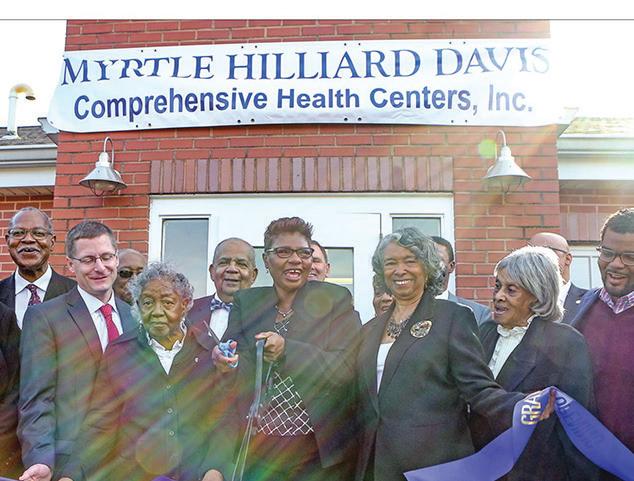

Mystery Story: Cut out several pictures from the newspaper without reading the caption. Place the pictures in a bag, and without looking, pick your mystery picture from the bag. That’s your stimulus for writing. Construct a graphic organizer to identify the 5Ws (who, what, when, where, and why) of your story by looking at your picture. Then, continue the writing process.
Figures of speech: Authors use figures of speech to be creative and descriptive. Can you find examples of similes, metaphors, alliteration, hyperbole, onomatopoeia,
Problem and Solution: Over a period of weeks, clip articles from newspapers that deal with problems and issues facing your local or county government. Discuss the reasons for these problems and how the government hopes to solve them.
Learning
Learning Standards: I can use the newspaper to locate information. I can categorize and summarize that information.
Learning Standards: I can use the newspaper to locate information. I can discuss problems and solutions. I can identify types of jobs. I can make text-to-world connections.



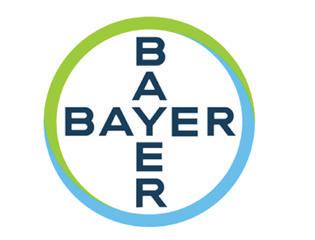



Louis and the Metro East.
The annual Thanksgiving dinner drive is one of the organization’s largest efforts to support families still recovering from a turbulent year — one marked by the devastating May tornado and the temporary suspension of SNAP benefits during the federal government shutdown.
Even as those programs resume and debris clears, many households continue to feel the strain.
The Urban League has responded with persistence, including doorstep deliveries in neighborhoods hardest hit by the spring storm.
“We are striving to remind people that there is still good in the world,” McMillan said. “There are still people who want to give their time, talent and treasure to make a difference.”
Among the volunteers was Elder Madsen of the Church of Jesus Christ of Latter-day Saints, who spent the afternoon lifting heavy boxes into backseats.
“Doing this brings peace and joy to others,” he said. “Seeing the outpouring of support warms my heart. I hope it sparks a light in others.”
Continued from A1 region. As federal benefits fluctuate and grocery access remains uneven, a network of Black farmers, food hubs and community groups has stepped in to fill widening gaps. Jones is one of the leaders shaping that response, expanding the small-scale growing tradition he learned as a child into a large, coordinated effort to feed thousands.
Today, Jones is the co-founder of Confluence

Alderwoman Laura Keys worked alongside volunteers, passing out turkeys and greeting families in their cars. For her, the meaning was simple: “It’s community coming together,” she said. “Feeding the people and doing the work.”
For some, the help
Farms in North County, which spans 240 acres, and the executive director of the North Sarah Food Hub.
The farm, located off Shackelford Road in Florissant, serves as an incubator for other farmers. It distributes produce baskets and packaged meals from its North City headquarters to hospitals, senior buildings, churches, food banks, Urban League sites and residents who call in need.
Since the North Sarah Food Hub opened in 2020, Jones’ organizations have distributed more than 3.5
couldn’t have come at a more critical moment.
Dominick Bounds, who lost his job last week, said the Thanksgiving drive will keep his family afloat this holiday.
“God is good,” he said.
“It’s a blessing to see so many people here to help us out.”
million meals and 4.5 million pounds of produce. Deliveries include fresh carrots, cabbage, collard greens and sweet potatoes, along with prepared meals such as herb chicken and roasted vegetables.
“We’re one of the few organizations that can put out the volume of food that we do,” Jones says. “We take our produce, we bring it into the city, and those crops are converted into meals.”
Jones is a member of Empowering Thriving Communities (ETC), a coalition of nonprofit food


In another car sat
75-year-old Wya Ali, who survives on $1,500 a month in Social Security — a figure stretched thin by rising costs.
“This is wonderful,” she said. “To see the community doing what the Urban League is doing is over and above what any
providers and farmers created by the St. Louis Integrated Health Network (IHN). ETC acts as a task force for hyperlocal groups working to address food deserts and expand access to healthier options.
“I didn’t feel like we had a choice not to act because of how critical food is to everyone’s well-being,” says IHN CEO Andwele Jolly. “This is a partnership. We are not at the center. The community is the center. Together, we make it work.”
Since 2021, under IHN’s mission, 81,000 people have been served through ETC food pantries, food banks, community gardens and urban farming programs.
Amid continued uncertainty around SNAP benefits and rising food insecurity since the month began, IHN leaned on its 35-member ETC group to help fill the tables of the residents they aim to serve.
“It is disappointing and disheartening to know that in a well-resourced country, we continue to limit access to food,” Jolly says.
“I think [our work is] a good fit for the work that they’re doing. It’s a
other community is doing.
If it wasn’t for the Urban League, we wouldn’t be here.”
Volunteers made sure each vehicle pulled away with everything needed for a traditional Thanksgiving — turkey, side dishes, desserts and beverages.
For families stressed by months of inflation, natural disaster recovery or simply the weight of daily life, the bags handed out this week carried far more than groceries. They carried relief. And for many in line, they carried a reminder that they had not been forgotten.
good match,” Jones adds. “We’re learning from each other and building something that is a solid foundation for the community.”
Gabrielle Cole, co-founder and executive director of the Fit & Food Connection, was one of the first ETC members after the pandemic. Her nonprofit focuses on providing North St. Louis City and County residents with food justice through quality access, urban farming and organic garden programs.
“IHN is setting an example for other larger institutions to step up and step in,” Cole says. “A lot of the ETC members are residents with lived experience, and we live in the community to design what this can look like, which is one of a kind.”
Since the government shutdown, members of the ETC collaborative have served 60,000 people, with children, older adults and people with disabilities among the most affected.
“The food insecurity is ridiculous in St. Louis. I’ve seen the disparities, and I’m one of those people who has faced them,” says North County resident Audrey Hollis. “I don’t know where St. Louis
would be without Black farmers.”
Hollis, 72, who lives in unincorporated Florissant and is on a fixed income, remembers relying on the ETC network after being released from the hospital.
“I was sick. I could barely walk,” she recalls. “I asked how much it was going to cost, and they said, ‘Nothing. Zero.’ That was really a shock to me. I started getting food delivered, and that has helped me so much.”
It was Jones and the North Sarah Food Hub that came to her aid. With an older husband and a disabled adult son, the support arrived just in time.
“A lot of times people come up to me and say, ‘You helped my grandmother. You helped my mother, my uncle, or grandfather.’ We hear it all the time,” Jones says. “What we grow impacts people’s lives. I’m proud of that.”
Reflecting on the holiday season, Hollis hopes others can be helped by the network.
“I just hope people have a meal on the table,” she says. “It’s a day of thanks, I just hope no one goes without a meal.”

At the conference, educators heard from national policymakers and attended workshops on student engagement, family involvement and the use of tools, such as artificial intelligence, in their classrooms. They also had opportunities to build connections with peers from across the country — something many said they rarely find in their home districts.
“I had the opportunity to join Ian Buchanan this year, and it’s been a phenomenal experience,” Murdoch said while attending the convening. “It’s so great to see all these Black males in educational leadership and higher education, because at times being the principal is the loneliest position in the school. It’s affirmed a lot of things for me.”
That sense of isolation is one of the reasons the Center for Black Educator Development exists. The Philadelphia-based organization hosts the annual convening.
Founder Sharif El-Mekki created the organization after realizing there was no group focused solely on encouraging Black children who want to become teachers, he said. He launched the BMEC as a small, local gathering, and when a group of Black male educators from Tennessee drove in for the meeting, he decided to expand the effort nationally, El-Mekki said. This year marks the event’s eighth anniversary.
This is the fourth group of Black male educators Buchanan has brought from the St. Louis area. The trip was sponsored by the nonprofit Opportunity Trust as part of its commitment to supporting educators in St. Louis. Buchanan said the convening helps educators like Murdoch build relationships that strengthen their practice and ultimately benefit the students they serve.
“They say iron sharpens iron,” he said. “So, I wanted to make sure that
Continued from A1
“Our goal is to provide exceptional emergency and inpatient services close to home, delivered with compassion and efficiency,” she said in a press statement. According to the hospital’s website, Archview will follow “the micro-hospital model, which emphasizes accessibility, efficiency and personalized care.”
The reopening comes less than a year after landowner and developer Paul McKee’s NorthSide Regeneration project launched what it marketed as a $20 million, 15-bed hospital in the same building. That operation opened in January 2024 but surrendered its state licenses and closed 11 months later, terminating more than 80 employees.
St. Louis real estate records show the entity that owned the facility during that closure — HGP Management LLC — still holds the licenses for the site. The company has been affiliated with McKee through former Franklin County Counselor Mark Vincent and other partners, according to the St. Louis Post-Dispatch.
The Missouri Department of Health and Senior Services is now working with Archview to secure its license, said DHSS spokeswoman Lisa Cox. If the facility begins seeing patients before mid-December, it will not need a new certificate of need, a state requirement intended to show there is sufficient demand for services in a given area.

people in the St. Louis region get connected to a national network. I also want them to continue to grow, and I want them to get the courage to know that they can be on a national stage and hold their own. So, that’s really why I do this.”
Over the last four years, 33 Black male educators from the St. Louis area have taken advantage of the opportunity to attend the BMEC, Buchanan said. Many found the event so valuable that they returned in subsequent years and encouraged additional
The original Homer G. Phillips Hospital, located at 2601 N. Whittier St., served generations of Black St. Louisans from 1937 until the city closed it in 1979 despite community protests. It became one of the nation’s leading training grounds for Black doctors and nurses during segregation and remains a revered symbol of excellence, equity and Black self-determination in health care.
That Art Deco campus was redeveloped in the early 2000s and now operates as Homer G. Phillips Dignity House, a senior residential care facility. It remains a City Landmark and is listed on the National Register of Historic Places.
The controversy stems from what residents and former Homer G. Phillips nurses described as an inappropriate use of the hospital’s name. McKee, through an affiliated company, opened a small, three-bed facility there in 2024 and named it Homer G. Phillips Memorial Hospital. Critics said the name was used without consultation or permission and did not reflect the scale or legacy of the original institution.
For many residents who remember or trained at the original hospital, the previous use of the name was painful and controversial. But some elected leaders say the circumstances have changed now that the name has been removed.
Fourteenth Ward Alderman Rasheen Aldridge, a frequent critic of the former naming, said he supports the new effort.
“I’m glad to hear that it’s opening up and also
educators to join them, he said.
Solomon Knight, assistant principal at Ladue Middle School, is among the repeat attendees. This is his second trip, and he said the convening has had a meaningful impact.
“Essentially, it just encouraged me and empowered me and emboldened me to continue the work that I was doing,” he said. “Being a Black educator, particularly in a space like Ladue Middle School, sometimes can be very hard to navigate.”
glad to hear they’re taking the name off of it,” Aldridge said. “The reality is that, not only is there a food desert (in his ward), there’s also a healthcare desert as well.
“A lot of people in the ward were hesitant to know it’s a Paul McKee project but excited to know that ‘hey, we’re going to get some type of emergency center.’ I stood with them on the misuse of Homer G. because it didn’t stand up to what the actual hospital was.
“At the end of the day, I think it’s a positive because we don’t need another vacant building. This is a fairly new building and on top of that, the name being removed is good. So, with new owners, I’m hopeful they’ll be able to operate longer than the former operators. It’s a plus because we do need a healthcare facility.”
By 2020, frustration with McKee’s broader NorthSide holdings had also deepened after he amassed hundreds of acres north of downtown but left much of it vacant and deteriorating.
Those unresolved tensions now hang over the latest effort to bring healthcare back to the North Grand building, raising questions about whether Archview can rebuild trust in a community still mindful of the Homer G. Phillips legacy even as some leaders express cautious optimism.
Nutex did not immediately respond to questions from The St. Louis American.
Sylvester Brown Jr. is the Deaconess Foundation Community Advocacy Fellow.
engagement gave him insights he plans to apply with students and families back home.
“I remembered a quote from Malcolm X in regard to education,” he said.
“He said, education is the passport to the
Today, in this moment, we are trying to create educational passports for our scholars.”

By Sylvester Brown Jr. St. Louis American
Outside the Clyde S. Cahill Courthouse, one of Sheriff Alfred Montgomery’s attorneys, Justin Gelfand, told reporters, “This was a ‘charge first and investigate later’ case.”
Montgomery’s legal team pushed back on three days of allegations from the Missouri Attorney General’s Office, which argued he failed to do his job, abused his authority and mismanaged office finances — grounds, prosecutors say, for removing him from office.
Both sides delivered closing arguments Tuesday before Circuit Judge Steven R. Ohmer, who will decide whether Montgomery keeps the seat he won in 2020.
Montgomery, indicted by a federal grand jury in August for alleged witness intimidation, is being held in federal custody. He appeared in court wearing a light-blue-washed plaid suit and red tie, handcuffed at the waist. Invoking his Fifth Amendment right, he did not testify.
“Today was a very important day,” Gelfand said. “We think evidence came forth today that should have been part of the attorney general’s investigation and its case.”
Gun seizure incident
lawmakers gave sheriffs responsibility over matters involving deputies, including secondary employment.
Handcuffing allegation
Montgomery’s defense also addressed allegations that he illegally ordered the handcuffing of acting deputy jail chief Tammy Ross after she refused his request to access a detainee connected to a sexual assault investigation.
The defense relied on testimony from former Master Sgt. Bryan Robins, who said he handcuffed Ross and did not recall Montgomery giving any such order. A subsequent police investigation led to the firing of the sheriff’s employee accused in the sexual assault case.
Financial accusations and jail custody
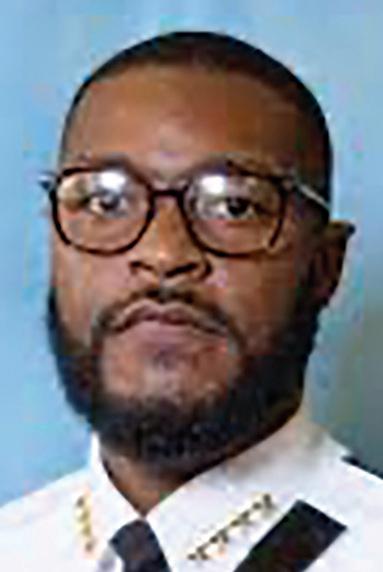
Prosecutors allege Montgomery illegally disarmed former sheriff’s deputy Darryl Wilson, who was working private security at a Phillips 66 gas station in January. “This case does not meet sufficiency of proof,” said former Judge David Mason, another defense attorney.
The defense acknowledged Montgomery confronted Wilson and took his weapon but argued the sheriff acted properly because Wilson — wearing tan pants and a black shirt resembling a sheriff’s uniform — misled the public after resigning. The gas station owner testified he hired Wilson believing he was still a deputy, after calling the sheriff’s office the previous year seeking off-duty help.
Body-camera footage showed a police lieutenant telling Montgomery he had no authority to take the gun. Gelfand countered that it is the Legislature, not police, that defines a sheriff’s powers and that
Defense lawyers rejected prosecutors’ claims of financial mismanagement, saying any concerns were “an accounting discrepancy” and that Montgomery had legal authority over spending. Prosecutors closed by arguing Montgomery cannot serve while jailed. “Being sheriff is not a remote position — it’s a full time, in-person job, and Alfred Montgomery can’t do it from a jail cell in Illinois,” said Assistant Attorney General Greg Goodwin. Mason urged the judge not to let federal detention determine the outcome, arguing Magistrate Judge John Bodenhausen had effectively “usurped” Ohmer’s authority by jailing Montgomery.
The case was brought under former Attorney General Andrew Bailey using the same quo warranto process he pursued in his unsuccessful effort to remove St. Louis Circuit Attorney Kim Gardner. Historically, the process has been used against Missouri sheriffs only after a conviction.
“What a quo warranto ultimately does is it literally overturns the results of a free and fair election,” Gelfand said. “There’s nothing that happened in this courtroom that we believe warrants that writ.”
With arguments complete, Montgomery’s future now rests with Ohmer.
Sylvester Brown Jr. is the Deaconess Foundation Community Advocacy Fellow.

By Jamala Rogers
The hype surrounding the release of the Epstein files has been described as a distraction, a conspiracy and even an act of retaliation. Much of the information about this child predator has been public for years. What has captured our attention more is the guest list, which includes names from the highest levels of society, even extending to a castle.
What continues to perplex me is the lack of outrage for the children who are victims — not only of Jeffrey Epstein and Ghislaine Maxwell but also of a global industry that exploits them sexually. U.S. society has shown indifference, except when certain cases are thrust into the spotlight, such as the ongoing scandal within the Catholic Church.
Before delving into the reasons for our collective indifference, let’s take a moment to consider the immense revenue generated by the sex industry, often referred to as the adult entertainment business. The era of simple peep shows and low-budget porn films is behind us.
few, weak laws on the books.
There are three reasons why I think it is challenging to take on the most perverse parts of the adult entertainment industry.
For years, we have heard about men in the entertainment world, like Harvey Weinstein and Diddy, abusing their power over women in various ways. The public concludes that this is an accepted part of the business, which potential victims should already know.
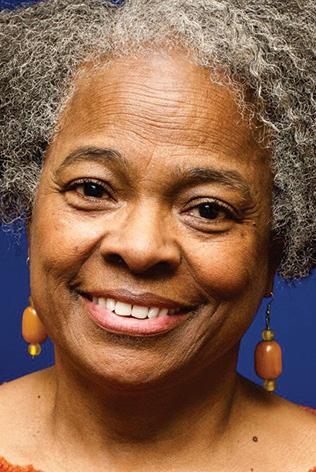
This mindset leads to my second point: the shame and guilt that victims experience can be paralyzing. This is one reason why many rape victims choose not to report the incident. The stigma is internalized not only by the consumers of the industry’s products but also by those who are directly harmed by the exploitative dynamics inherent in the business. Victims are often blamed since most of the public does not grasp the concept of “grooming.”
With the integration of media, retail products, advertising, streaming and advanced technologies, the industry has evolved into a sophisticated and lucrative enterprise that has shed much of its stigma. This sector is an estimated $100 billion global industry with long corporate tentacles.
Well-known names like Playboy and Larry Flynt Publications are joined by less familiar companies such as MindGeek, Vivid and AVN. Companies like AT&T, Time Warner, DirecTV, Hilton, Sheraton, Visa, MasterCard and American Express get a piece of the action based on the services they provide.
Acquiring accurate data regarding the industry is extremely difficult. While it strives for omnipresence, it simultaneously prefers to operate in the shadows. It’s mainly hiding from regulation, which doesn’t seem to be a problem for the industry, nor does enforcement of the

The third explanation is related to the previous one. I think it’s hard for the general public to listen to the horrors suffered by adult victims when they were children. People only see adults. That’s why it’s been crucial for the Epstein victims to show that they were girls when first recruited by Maxwell to provide services to grown men.
I’m not suggesting that morality is solely linked to sexual matters. What I’m saying is that when a nation’s moral compass is compromised in one area, it often reflects compromises in other areas. This country is spiraling out of control, and we seem to have forgotten what truth, fairness and justice look like. Moral corruption often precedes political corruption. This is one of the battles we face in the effort to preserve this democracy.
Jamala Rogers is an opinion writer and one of the founding members of the Organization for Black Struggle, based in St. Louis.



Know before
choose the

“They found a hole in my
this
and then I had to have another surgery. They say everybody has two lives, and the second life starts when you realize you have one.” - Donald Glover on taking time off

By Zaria Mac
The Bullock Ballroom at Live! by Loews in Ballpark Village pulsed with funk and fire last night as fans gathered for “Through the Fire.” Two St. Louis vocal powerhouses joined forces for an electrifying tribute to the incomparable, multi-Grammy Award–winning Chaka Khan. Thanks to Tish Period and Cherise Louis Mason, the evening honored her with a blend of reverence and creativity. Paying tribute to Chaka Khan is no small feat. Her catalogue demands soulful depth and sky-high vocal agility. Yet from the moment the lights dimmed, it was clear Period and Mason were more than ready to rise to the challenge. Rather than replicate Khan’s iconic recordings
By Zaria Mac St. Louis American
St. Louis was shaking—literally—last night as Sexyy Red returned to her hometown to headline the unapologetically ratchet Sexyy Red & Friends. For nearly four hours, the Enterprise Center thumped with heavy bass, flashing lights, and the kind of rowdy, joyful chaos only Sexyy Red can command. Fans filled the arena, draped in red braids, fresh lace fronts, and outfits ready for twerking at a moment’s notice.
Hosted by the animated and endlessly clowning Ben Da Don, the night was a rotating parade of chart-toppers, underground favorites, and surprise guests who kept the crowd buzzing with the constant anticipation of who’s coming out next. Every seat was filled with fans cackling at Ben’s jokes while anxiously waiting for the Northside shero herself to appear.
Bursting out in a frosted black denim jacket and pants set, she launched the night with her fiery anthem “Get It Sexyy,” the title flashing in bold red graphics behind her. Before the beat even settled, she leaned into the mic and let out her signature “BOW BOW BOW BOW,” instantly detonating the arena. Phones shot up like fireworks as thousands screamed the lyrics right back at her. Without missing a breath, Red slid straight into “Hoochie [expletive].” The song turned the floor into a sea of shaking bundles and perfectly executed angles as women recorded themselves twerking beside their friends.
note-for-note, the two vocalists infused their own artistry, threading Chaka’s essence through their unique styles. The result was a celebration that felt authentic, passionate, and refreshingly original.
Supporting them was a full band dressed in black ensembles—horns, guitars, drums, and “Dr. Phil Good” Graves on keys. The dynamic musicians filled the ballroom with a sound that was both polished and playful. Flashing red and purple strobe lights washed over the stage, providing the evening with a full concert atmosphere that had the crowd swaying, clapping, and recording on their phones before the night was half over.

Then came the throwback everyone was waiting for “Chicken Chicken.” Red peeled off her jacket. She revealed glistening skin and a black bra top. She twerked under the lights as fans shouted every word. She strutted across the stage, dancing and dropping low before
For nearly four hours, the Enterprise Center thumped with heavy bass, flashing lights, and the kind of rowdy, joyful chaos only Sexyy Red can command.
welcoming her first special guest of the night: Loe Shimmy. The crowd erupted as Shimmy stepped out performing “3 am,” shouting “put you
in your place!” to the arena of screaming fans. Meanwhile, Sexyy Red danced behind him with the kind of seduction only she can pull off. He followed with “For Me,” with Red jumping in to hype the adlibs like they were tag-teaming a house party performance.
Just as fans caught their breath, Rob49 stormed the stage to deliver a bass-booming performance of “WTHELLY.” The men in the audience nearly shook the building yelling the chorus while the women twerked in circles, letting the beat take full control of their hips.
Momentum only built from there as Sexyy Red lit up the arena with “Skee Yee.” She turned the room full of pretty girls into the most gangster choir imaginable. After tearing through “I Love My Nickel,” she brought out another queen of raw lyrics and even wilder energy: Sukihana. Together they performed

Tue., Dec. 2, doors 6:30
p.m. Cirque Musica Holiday Wonderland, The Factory, 17105 N Outer 40 Rd, Chesterfield, MO 63005. For more information, visit www. thefactorystl.com.
Fri., Dec. 5-6, 7:30 p.m. The Bosman Twins: For The Holidays, Blue Strawberry Showroom and Lounge, 364 N. Boyle Ave, St. Louis, MO 63108. For more information, visit https://bluestrawberrystl. com.
Thurs., Dec. 18 – Fri., Dec. 19, 7:30 p.m., St. Louis Symphony Orchestra IN UNISON Chorus presents IN UNISON Christmas with the Clark Sisters, Powell Symphony Hall. For more information, visit www.slso.org.
Fri., Dec. 19, doors 7 p.m. Funky Butt Brass Band BRASSTRAVAGANZA, Delmar Hall, 6133 Delmar Blvd, St. Louis, MO 63112. For more information, visit www.thepageant.com.
Sat., Dec. 20 – Tues., Dec. 23, Mercy Holiday Celebration starring Kennedy Holmes and the St. Louis Symphony Orchestra, Powell Symphony Hall. For more information, visit www.slso.org.
Through Jan. 11, Gateway Arch Park Foundation’s Winterfest, Kiener Plaza, 500 Pine St, St. Louis, MO 63101. Build your experience at www. archpark.org.
Sun., Dec. 14, 5 p.m. & 8:30 p.m. Eric Benet: Holiday Tour,
City Winery St. Louis, 3730 Foundry Way, St. Louis, MO 63110. For more information, visit https://citywinery.com.
Tue., Dec. 16, 7 p.m. Through the Tesseract Cabaret Series: Becoming Her starring Margery Handy, Marcelle, 3310 Samuel Shepard Dr, St. Louis, MO 63103. Purchase tickets at www.metrotix.com.
Mon., Dec. 22- 23, 6 p.m. Raheem DeVaughn in 20 Lessons of Love Tour, City Winery St. Louis, 3730 Foundry Way, St. Louis, MO 63110. For more information, visit https:// citywinery.com.
Sat., Nov. 29, 8 p.m., Café Soul The Reunion, House of Soul, 1204 Washington Ave. For more information, visit houseofsoulstlouis.com.
Sun., Nov. 30, 7 p.m. R&B Bowling After Dark, Tropicana Lanes, 7960 Clayton Rd, Richmond Heights, MO 63117. Purchase tickets here, www. eventbrite.com.
Fri., Dec. 19, 10 p.m. DJ MuDa Presents: Vol. 3 Reimagined, The Dark Room, 3610 Grandel Sq, St. Louis, MO 63103. For more information, visit https:// kranzbergartsfoundation.org.
Fri., Nov. 28 – Sun., Nov. 30, St. Louis’ own Lavell Crawford, Helium Comedy Club, 11151 St. Louis Galleria Street, St. Louis, MO 63117. For more information, visit https:// st-louis.heliumcomedy.com. Sun., Dec. 7, 7 p.m. Special Event: Vincent Bryant, Helium

Comedy Club, 11151 St. Louis Galleria Street, St. Louis, MO 63117. For more information, visit https://st-louis. heliumcomedy.com.
Wed., Dec. 10, 5 p.m. doors, Earthquake, City Winery St. Louis, 3730 Foundry Way, St. Louis, MO 63110. For more information visit https://citywinery.com.
Fri., Dec. 19, Special Event: Corey Holcomb, Helium Comedy Club, 11151 St. Louis Galleria Street, St. Louis, MO 63117. For more information, visit https://st-louis.heliumcomedy.com.


ST. LOUIS MUSIC SPOTLIGHT
Fri., Nov. 28 - 29, 7:30 p.m. Denise Thimes in Thanks to Friends, Family, and Inspirations, Blue Strawberry, 364 N. Boyle Ave, St. Louis, MO 63108. For more information visit https://bluestrawberrystl.com.
Sat., Nov. 29, 8 p.m. DJ Stan Da Man, Atomic Lounge, 4140 Manchester Ave, St. Louis, MO 63110. For more information, visit www.jamopresents.com.
Through Dec. 31, 11 a.m. Jazz Sunday, Beatnik Bob’s in City Museum, 750 N. 16 St.
St. Louis, MO 63103. For more information, visit https://citymuseum.org.
Thurs., Dec. 4, 7 p.m. Hairspray, The Grandel Theatre, 3610 Grandel Square, St. Louis, MO. 63108. For more information, visit https://ignitewithus.org.
Through Dec. 7, 7:30 p.m. The Wiz, The Fabulous Fox, 527 N. Grand Blvd, St. Louis, MO 63103. Various showtimes available. For more information, visit www.fabulousfox.com.
Thur., Dec. 4 - 20 Superhero book by John Logan, Stray Dog Theatre, 2336 Tennessee Ave, St. Louis, MO 63104. For more information, visit www. straydogtheatre.org.
ART
Through February 1, 2026, Jennie C. Jones: A Line When Broken Begins Again, Pulitzer Arts Foundation and Museum, 3716 Washington Blvd, St. Louis, MO 63108. For more information, visit https://pulitzerarts.org.
Through February 8, 2026, Teresa Baker: Somewhere Between Earth and Sky, Contemporary Art Museum, 3750 Washington Blvd, St. Louis, MO 63108. For more information visit, https://camstl.org.
Through June 2026, The Future Is Female, 21c Hotel and Museum Hotel St. Louis, 1528 Locust St, St. Louis, MO 63103. For more information, visit https://21cmuseumhotels. com.




Continued from B1
Tish Period kicked off the night with the unmistakable opening of “I Feel for You,” instantly igniting the audience. They recognized the melody within seconds, nodding along and cheering as Period delivered the hit with spirited confidence. She followed with “Hollywood,” a deep cut from Khan’s Rufus era—an unexpected but appreciated treat for the true Chaka fans in the room.
Red lights spiraled across the space before fading into soft pink as Tish Period transitioned into “Ain’t Nobody.” The band layered in drums, guitar, and horns with a slow, deliberate build, letting the crowd settle into the familiar groove. Period’s bold vocals danced over the rhythm as she moved across the stage, visibly enjoying every beat.
She shifted gears with a velvet-smooth rendition of the cabaret classic “My Funny Valentine,” her voice traveling through smoky lows and bright, soaring highs. Period’s improvisational runs gave the standard new shape and emotional texture.
After another deep cut— “What Cha’ Gonna Do for Me”—she closed her set with the timeless anthem “I’m Every Woman.” Cheers erupted at the iconic opening line, “I can cast a spell,” while phones rose across the ballroom to capture the moment.
Then, under vibrant hot-pink lighting, Cherise Louis Mason claimed the stage with an exuberant “This Is My Night.” Her joy radiated outward, flowing effortlessly through the melody. The lights deepened to a regal purple as she shifted into the sultry groove of “Everlasting Love,” prompting audience members to tap their
Continued from B1
“Hood Rats,” with Suki dropping splits in her hot pants and a fur bra top like she owned the entire building.
Then came the song that changed Sexyy Red’s life—“Pound Town.” She called her sisters and friends to the stage, instantly recreating the wild, carefree fun of her music videos. The timing was perfect for her next guest: Pluto, who strutted in to join Red for “Motion.” The two performed side by side like twin flames before Pluto gave the crowd a jolt with performances of “WHIM WHAMIEE” and “Pull Yo Skirt Up.”
But the loudest scream of the night came when Chicago legend G Herbo marched out under flickering green strobes for “I’m Rollin’.” Fans practically drowned out his vocals

feet and hum along softly.
Mason followed with a dreamy, mesmerizing performance of “One for All Time,” guided by Dr. Phil Good’s piano, before launching into a funkier energy for “Sweet Thang.” Peppered with reggae rhythms, the song opened with an electric-guitar solo by Lamont Patterson as the background singers swayed behind her. Encouraging fans to clap along, Mason brought the crowd to life during “You Got the Love.” She stepped off the stage, weaving through the audience, giving hugs, laughing, and singing directly to guests. The band amplified the moment with a lively, almost chaotic funk rhythm that turned the ballroom into a full-blown party. Her finale, “Through the Fire”—the concert’s namesake—arrived wrapped in glowing red lights and
singing along, before he switched into “Went Legit,” punching his verses out with precision. Then Sexyy Red re-emerged in a red shortsand-bra set topped with a long red fur coat, ready to reclaim her show. She tore into “I’m the [Expletive]” and “Bow Bow Bow ([Expletive] My Baby Dad)” with seductive confidence before unleashing the chaos-inducing “Hellcats SRT’s.” By then the entire arena was dancing, with no exceptions. More hits followed, from her raunchy staples to her newer smashes like “Rich Baby Daddy.”
But just when the audience thought they’d seen the peak, Red delivered the grand finale. She brought out the legendary Louisiana trap music duo Boosie and Webbie—and the arena exploded. They launched into the club classic “Wipe Me Down,” sending the crowd into a frenzy as everyone mimicked the famous wipe-down
dreamy ‘80s-style synths.
Hands shot into the air as the chorus hit, phones lifted again to capture her soaring vocals. The background singers delivered a standout bridge, filling the room with rich harmonies as Mason powered through the song’s final, demanding notes.
Together, Tish Period and Cherise Louis Mason didn’t simply revisit Chaka Khan’s legendary catalogue—they reimagined it with fearless creativity, bold artistry, and undeniable vocal power.
“Through the Fire” emerged as far more than a tribute; it became a vibrant testament to the timeless influence and joy woven into Chaka Khan’s music. It was also a shining reminder that St. Louis possesses the talent to honor Khan’s legacy with brilliance and soul.
motions. The energy soared as they ran through “Mind Ya’ Business,” “G [Expletive],” “Set It Off,” and “My People.” Each song turned the Enterprise Center into a full-blown block party.
Throughout the night, Red kept the surprises rolling. She brought out artists like Glorilla for “WHATCHA KNOW ABOUT ME,” and FendiDa Rappa and Shamar Marco for “Clock Dat.”
To close the night, Sexyy Red performed the viral fan favorite “Sexyy Walk.” As the lights dimmed, she smirked and tossed one final line over her shoulder: “Imma show you how to walk off on a hater.”
And just like that, she was gone—leaving St. Louis still buzzing, still screaming, still proud of their hometown superstar who brought all her friends home for one unforgettable, beautifully chaotic night.

Continued from B1
St. Louis region. He gave fans the chance to relive the album that introduced him to the world — the project that made him not just a name, but a fixture in R&B.
This wasn’t the EGOT winner who sold out The Muny last year. Nor was it the superstar who captivated tens of thousands beneath the Arch. At The Factory — a venue that feels intimate compared to his star power — Legend offered a tribute to his climb.
The set included a handful of nods to his two decades of Grammywinning impact, along with a few gems from before his debut. But as the tour’s title promised, this was a show curated for his day-one fans.
“Come on and go with me, there’s something new for you to see,” Legend sang, opening the night exactly as he opened “Get Lifted” in 2004.
Back then, listeners pressing play on their CD players couldn’t have imagined the journey ahead. Legend had Kanye West’s co-sign — at the time, West was at the peak of his influence as both rapper and producer. But beyond that stamp of approval, and a few songwriting credits and hooks for Lauryn Hill, Common, Alicia Keys, and West himself, Legend was still largely unknown.
His debut single “Used 2 Love U” earned modest radio play. But “Ordinary People” erased any obscurity. With that ballad, he arrived — and he never looked back. Two decades later, his name rests comfortably among R&B’s elite, with crossover appeal that expanded the genre’s reach.
Onstage, Legend honored “Get Lifted” by performing the album in order, track by track. For

purists — including this reporter — his decision to keep arrangements close to the originals was a gift.
Still, he avoided monotony by weaving in hits from later albums every few songs. “Heaven Knows” and “Save Room,” both from his platinum-selling sophomore project “Once Again,” were early highlights.
The show was strong throughout, but Legend was at his most powerful behind the piano. Deep cuts like “Stay With You” and “It Don’t Have to Change” reminded the audience of the raw intimacy that first defined him.
He also made sure the night wasn’t one-dimensional. Fans got to dance along to “Green Light,” “Ooh Laa,” “Slow Dance,” and “Tonight.” He paid homage to his songwriting and feature work with Estelle’s “American Boy” and Hill’s “Everything Is Everything.”
One of the evening’s most delightful surprises came when Legend revisited his early Philadelphia days. His takes on Bilal’s neo-soul classic “Soul Sista” and Musiq Soulchild’s “Just Friends” showcased his versatility and reverence for the scene that shaped him. Of course, he made room for crossover staples like “All of Me” and his duet with Meghan Trainor, “Like I’m Gonna Lose You.” But he never lost sight of the tour’s purpose. “The Get Lifted 20th Anniversary Tour” closed just as the album did — with “Live It Up.” The bonus track carried the audience home on a groove that felt prophetic—a midtempo promise of his future in music and in life: “We can fly so high, in the moonlit sky… It’s so beautiful, when you feel the flow… We can dance the night away.”


Cherise and Tish were the heat and the fire! When I tell you Cherise Louis Mason and Tish Period did not come to play with their “Through The Fire” Chaka Khan tribute Friday night at Live By Loews, you had to be there to truly understand what I mean. From the moment I heard who was singing, I knew Chaka’s catalog was in good hands. And they made a good thing even better with that insane band led by Phil “Dr. Phil Good” Graves Fred Lamont Patterson—listen, I don’t know what your foot is going through with that surgery boot, but your fingers were downright bionic on that reggae spin of “Sweet Thing.” Watching Cherise and Tish slay to the point where I can guarantee Chaka’s finicky self would’ve been pleased had me full of STL pride. And they didn’t just honor Chaka— they stood ten toes down in their own gifts, bringing pure STL flavor to her iconic songs. The whole show felt like a love letter to Chaka, to Black women’s voices, and to the talent rooted deep in St. Louis soil.

Northside’s finest could. Can I share the full setlist without being banned from the paper or possibly arrested? Absolutely not. But just know—a time was had! So much so that I caught myself accidentally singing “Skee Yee” to the beat of Byron Cage at church the next morning. What? At least it wasn’t “Pound Town!” Honestly, that show belongs in the Guinness Book of World Records for the largest crowd of nonstop twerking. Then she had the nerve to bring Boosie and Webbie out. That “Wipe Me Down” break gave those knees just enough reprieve to “throw it in a circle” for the rest of the night. And don’t even get me started on the next-level energy Glorilla brought with her. Yes, I know there was an incident after the show based on what somebody thought they heard. But the show itself? I wasn’t the least bit mad about it. And I’ve got to shout Sexyy out for partnering with Prince Beauty Supply to bless folks this Thanksgiving.



Sexyy put on for STL. Listen, I know her presence is polarizing. St. Louis folks either absolutely love or utterly hate Sexyy Red. In full transparency, I can be totally conflicted when it comes to her. But let me go ahead and tell the haters looking for Sexyy Red slander to skip down to the next item, because I’ve got nothing but love for how she turned Enterprise Center into a straight-up St. Louis block party Saturday night. She had the bust down and quick weave girlies bopping and twerking like only the
Steve Lacy’s legacy continues. On Sunday, I made my way to “Legacy 101: A Steve Lacy Experience” at the Moto Museum. To paraphrase my boy K.Dot, the way Steve popped back out and showed the folks needs to be studied. He jumped back in his promoter bag a whole generation later—and in only two events he has gagged us like he never left! Steve, sir, did you slay a silk press and say to yourself, “Girl, I’m gonna give you someplace to wear this…” or what? For this latest daytime triumph, he set the dress code as creative formal. And y’all took that to heart!
I’ve been going to galas all my life and I have never—and I do mean never—seen a camouflage evening gown before Sunday afternoon. The girls and the guys came through. Mocha Latte gave her own spin on a Morticia Addams-inspired ensemble. The pearls were a super cute touch. Skylar Barnes turned heads with that marital veil, jacket, head usher gloves, and birdcage purse. And now that the event is over, I can confess: I was the one tossing shrimp fried rice behind you like a flower girl— just like those women sprinkling rose petals for Eddie Murphy in “Coming to America.” Had
this been anybody else’s party, Skylar would’ve shown up the host. But it was a Steve Lacy party. He said, “I’m going to be wearing a brooch, but I want the whole left side of my jacket to be its own brooch to match it. And give me some gloves—and a sickening cropped silhouette cut to this jacket so that nobody, and I do mean nobody, can outslay me.” Other looks of note: Shaki in that leopard dress. Lady Re dressed in all black like the omen, and Gab Hays serving golden Hollywoodera bombshell glam. And Mr. Kevin—your new name is Mr. Forest Green Fascinator Veil
A stroll down Café Soul’s memory lane. Since we’re on the subject of legacy, let me remind y’all one more time: Café Soul: The Reunion is going down Saturday at The House of Soul (1204 Washington Avenue). If I could curate Saturday night’s show, I’d have CJ Conrod, Wil Robinson, Cherise Louis Mason, Tish Period, Wild Mann, Tiffany Elle, Theresa Payne, and a few others I’m forgetting to put it down for the old days—while making room for the new generation to flex their talents. What I do know is the band is stacked with Café Soul alum: Dirty Lint on drums, Mark Harris II on keys, Fred Lamont Patterson on guitar, and Bud on bass. And my girl Tendai Morris will be back as the hostess with the mostess. It’s going down Saturday, Nov. 29. The party starts at 8 p.m.

Don’t miss


Thu 7:30pm Fri 7:30pm Dec 18–19
“We’re a very dangerous team.”
— Notre Dame running back and former CBC standout
Jeremiyah Love

With Earl Austin Jr.
St. Louisan Jeremiyah
Love of Notre Dame is officially on the Heisman Trophy watch after another spectacular performance last weekend.
The former CBC standout rushed for 171 yards and scored three touchdowns on only eight carries in Notre Dame’s 70-7 victory over Syracuse. On his third touchdown of the day, a 68-yarder, Love struck the Heisman Trophy pose.

With each game, Love continues to move up the charts in Notre Dame’s record books. His three touchdowns give him 20 for the season, which ties former Irish great Jerome Bettis for most touchdowns in a single regular season at Notre Dame. Love also has 41 career touchdowns, which passes Bettis for third place on Notre Dame’s all-time career list.
For the season, Love has rushed for 1,306 yards on 185 carries and 17 touchdowns. He also has 26 receptions for 274 yards and three touchdowns.
Notre Dame (9-2) will host Stanford in the regular season finale on Saturday night in South Bend, Indiana.
East St. Louis returns to the State Finals
The East St. Louis Flyers are back in the IHSA Class 6A state championship game for the fifth consecutive year. The Flyers went on the
road and came away with a dominating 50-7 victory over Burbank St. Laurence in the state semifinals last Saturday. The Flyers’ running back tandem of Myson JohnsonCook and Ahmad Coleman did most of the offensive damage as they combined to score seven touchdowns. Johnson-Cook scored four touchdowns while Coleman added three scores.
East St. Louis will face Oak Park Fenwick on Saturday in the Class 6A state championship game at Hancock Stadium at Illinois State University. Kickoff is at 1 p.m. A victory will give the Flyers their third state title in the past five years.
Top playoff performers from last weekend
Senior quarterback Cooper Owens of Kirkwood completed 25 of 35 passes for 459 yards and four touchdowns in the Pioneers’ 70-56 victory over Farmington in the Class 5 quarterfinals.
Senior wide receiver Jacob Eberhart of Kirkwood had seven receptions for 143 yards and two touchdowns in the Pioneers’ 70-56 victory over Farmington in the Class 5 quarterfinals.
Senior running back Manny Ellis of

struck the Heisman Trophy pose.
Cardinal Ritter rushed for 191 yards and three touchdowns in the Lions’ 38-13 victory over Fort Zumwalt North in the Class 5 quarterfinals.
Sophomore quarterback Trevor Beckermann of Pattonville passed for 344 yards and rushed for 133 yards and had four
touchdowns in the Pirates’ 56-42 victory over Fort Zumwalt West in the Class 6 quarterfinals.
Senior running back Collin Griffin of Kirkwood rushed for 231 yards on 21 carries and four touchdowns in the Pioneers’ 70-56 victory over Farmington in the Class 5 quarterfinals.
With Alvin A. Reid
Missouri State Semifinals Schedule (All games scheduled for Saturday at 1 p.m.)
Class 6 Nixa at Pattonville Jackson at Lee’s Summit
Class 5 Platte County at
Class 3 Lift for Life vs. St. Michael the Archangel at Liberty North Seneca at St. Clair

The Dallas Cowboys stunned the Philadelphia Eagles 24-21 after falling behind 21-0 in the first half last Sunday. The comeback was the largest in Cowboys history and it certainly had me and a friend watching the game cheering like we were in AT&T Stadium in Dallas. The game reminded me of one of my favorite Cowboy comebacks, which happened on Thanksgiving Day Nov. 27, 1994. While my wife and I resided in the Washington, D.C. area from 1991 to ’95, we would go to an aunt’s home on a ridge that overlooked Walter Reed Medical Center.
A cousin of mine and my sister’s husband are also Cowboys fans. Go figure, they grew up in the heart of sheer Cowboys hatred. (Redskins, ugh.)
Watching the Cowboys game was a must each Thanksgiving afternoon, and the 1994 game was a
year after the 1993 debacle featuring defensive tackle Leon Lett.
The Cowboys blocked a field goal to preserve a late-game lead over the visiting Miami Dolphins as sleet covered the Cowboys Stadium field. A guaranteed victory was lost when Lett inexplicably decided to slide into the football while attempting to pick it up. The Dolphins recovered the “fumble,” and would kick the game-winning field goal.
The Cowboys would go on to win the Super Bowl that season, by the way.
The 1994 game saw an injured Troy Aikman unavailable to play and a young guy with red hair out of Princeton got the call at QB.
Jason Garrett and the Cowboys fell behind 24-13 against the 6-5 Packers and Hall of Fame quarterback Brett Favre. It looked like another Turkey Day disappointment.
But Garrett, who would later become Cowboys head coach, threw for a pair of touchdowns, one to Michael Irvin, and led two other drives that ended in TDs.
When all was said and

done, Garrett had 311 yards passing and the Cowboys prevailed 42-31.
Garrett was named the game’s MVP and got to munch on a turkey leg while the late John Madden and Pat Summerall interviewed him on CBS.
Here’s the best part of the story. Garrett didn’t down the entire turkey leg. He preserved it in the freezer.
Garrett, who is part of the NBC Sunday Night Football broadcast team, shared this story after a Thanksgiving night game.
“I had it in the freezer. It was in tinfoil…I
probably had it for 15 years. And then we finally moved, and I called my wife the other day and I said, ‘Do we still have the turkey leg?’ She said, ‘No, it’s long gone.’” Happy Thanksgiving, good people!
The Reid Roundup Jason Garrett’s Thanksgiving game comeback came with Barry Switzer in his first year as head coach. Owner Jerry Jones made the stupidest move in Dallas Cowboys’ history when he fired head coach Jimmy Johnson after the ’93
Nate Newton (61) protects QB Jason Garrett (17) during the Dallas Cowboys comeback on Thanksgiving Day 1994.
Super Bowl season...While the Cowboys joined the Detroit Lions in hosting annual Thanksgiving games in 1966, the NFL didn’t do Dallas a favor. It asked for a volunteer franchise and the late owner Clint Murchison Jr., was smart enough to grasp the opportunity… In 1975 and 1977, NFL Commissioner Alvin “Pete” Rozelle experimented with other teams playing on Thanksgiving. On November 27, 1975, O.J. Simpson and the Buffalo Bills visited Busch Stadium to take on the St. Louis Cardinals. The Bills hammered the Big Red
32-14 on a snowy, freezing day…A little-known Bills running back named Jim Braxton stole the show from O.J. rushing for 160 yards and three touchdowns. Simpson finished the game with 85 yards and a touchdown… Cardinals QB Jim Hart threw four interceptions and vaunted running back duo of Jim Otis and Terry Metcalf combined for only 58 yards rushing…I remember that game like it was yesterday because I was there. The annual Turkey Day Game between Kirkwood and Webster was rescheduled to Nov. 29 because heavy snow blanketed Lyons Field in Kirkwood on Thanksgiving Eve… Cowboys QB Dak Prescott broke Tony Romo’s record (34,183) for most career passing yards in Cowboys history during the win over Philadelphia. Prescott, who passed for 354 yards against the Eagles, now has 34,378 passing yards…Patrick Mahomes and the Kansas City Chiefs visit Dallas on Thanksgiving. The game might set a Turkey Day TV viewing record.
Black Rep founder honored in NY for transforming St. Louis’ cultural landscape
By Kenya Vaughn St. Louis American
When Ron Himes walked into the 53rd annual AUDELCO Awards—the nation’s premiere celebration of Black theater—he felt something he didn’t expect. A jolt hit him when his name was called as a Lifetime Achievement Award recipient. The founder and producing director of The St. Louis Black Repertory Company says the moment was “humbling, exhilarating, and monumental”— not just for him, but for the St. Louis institution he has spent nearly five decades building.
“The room was electric,” Himes recalled. “To be recognized in that space, with people who have shaped Black theater for generations—and to be in the presence of Woody King Jr. again—was over-
whelming. It was an honor to join that choir.”
That “choir,” as Himes describes it, is the collective of Black theatermakers who created AUDELCO more than 50 years ago to honor Black artistry at a time when mainstream institutions refused to do so. To now stand among that lineage on the eve of The Black Rep’s 50th anniversary made the recognition even more meaningful.
Elizabeth Van Dyke, producing artistic director of the New Federal Theatre, introduced Himes at the ceremony.
“A director, leader, organizer, visionary, producer, builder, administrator, impresario,” Van Dyke said. “An actor, performer, thespian, accomplished master. An esteemed artistic comrade to many across the United States and around the world. Ron


Himes possesses a knowledge and love of Black history, Black people, our ancestors, our contributions, our legacy, and for those who paved the way.”
For Himes, the award validates the work of a company founded not in New York or D.C., but in St. Louis—with a mission rooted in local talent and audiences.
“We are a company based in St. Louis, founded in St. Louis, producing work for St. Louis,” Himes said. “We’re committed to using and developing local artists. To have that mission recognized on a national stage—it’s a wonderful affirmation of what we’ve built.”
Since its founding in 1976, The Black Rep has grown into one of the country’s premier Black theater companies. Its alumni stretch across film, television, regional
theaters, Broadway, and arts institutions nationwide. And its fingerprint is everywhere in the St. Louis arts ecosystem.
“You can’t go into almost any theater in St. Louis and not see someone who came through The Black Rep,” Himes said. “We cultivated the talent that fills stages across this city. For so many, our stage was their launching pad.”
The Black Rep wasn’t founded to be groundbreaking—it became that because the void it filled was deep and unaddressed.
“When we started 49 years ago, it often felt like I was in a wilderness by myself crying out,” Himes said during his acceptance speech. “But over time,
Ron Himes, founder and producing director of The St. Louis Black Repertory Company, received a Lifetime Achievement Award at the 53rd annual AUDELCO Awards on Monday, November 17 in New York City.
Photos courtesy of The Black Rep
going to New York, connecting with other Black artists, working with Woody King—I realized I wasn’t in the wilderness alone. I was just part of a choir I hadn’t met yet.”
The Black Rep’s reach extends far beyond St. Louis. Himes delights in seeing alumni thriving— from actors taking roles in major regional productions, to former students directing nationally, to talent returning home to give back.
“That’s legacy,” he said. “People are excited to be part of what The Black Rep represents— some because it shaped their artistic lives, others because they understand its history and want to contribute to it.”
He shared examples with the warmth of someone talking about family: alumni directing acclaimed productions such as “Covenant” at Atlanta’s Alliance Theatre—and St. Louis talent making waves in major musicals like Robert Crenshaw in the Broadway national tour of “The Wiz” (which will be at The Fabulous
Fox through December 7) and Rheaume Crenshaw (no relation to Robert) in Lincoln Center’s production of Ragtime.
“These artists go out into the world and make their mark,” he said, “but you can still see The Black Rep in their work.”
After 49 years, the mission hasn’t changed: tell Black stories, build Black talent, and serve Black audiences—with excellence. And now, thanks to the AUDELCO Awards, the nation is applauding the work St. Louis has celebrated for nearly half a century.
Awards aren’t the goal for Himes—but he admits they matter, especially when the work gets tough.
“There are peaks and valleys in this work,” he said. “Sometimes it feels like more valleys than peaks. When you’re in one of those valleys, you ask yourself, ‘Why do I keep doing this?’” Then a recognition like this comes—national, historic, rooted in Black artistic lineage.
“And suddenly you get the fuel you need to keep going,” Himes said. “This honor will absolutely be a catalyst as we move into our 50th anniversary. It’s a badge of honor we’ll carry into the next chapter. We always want people to come out, support, and be part of what we’re building.”
The Black Rep’s 49th season continues with The Dance on Widow’s Row, which runs January 7-25 at Washington University’s Edison Theatre, 6465 Forsyth Blvd. For tickets and additional information, visit www.theblackrep.org.

























The terms of three current members of the Normandy Schools Collaborative (NSC) Joint Executive Governing Board (JEGB) are set to expire on June 30, 2026. An election will be held to fill their positions.
The public will vote for candidates on the April 7, 2026, ballot, and the newly elected members will join the Board in April 2026 and serve for three years Individuals who wish to run as candidates have a three-week window to apply. Per state statute § 162.083, RSMo, the filing period for the April election begins Tuesday, December 9, and closes Tuesday, December 30, 2025. Candidates must be residents of the Normandy Schools Collaborative geographic footprint.
According to the Missouri School Board Association, school board candidates must meet the following requirements:
• A United States citizen.
• A resident taxpayer of a district or voter of the district in urban districts.
• A resident of Missouri for at least one year.
• At least 24 years old.
Candidates must file in person at the St. Louis County Board of Elections, 725 Northwest Plaza Drive, St. Ann, MO 63074, between 8 a.m. and 4:30 p.m., Monday through Friday. Filing ends at 5 p.m. on the last day of candidate filing only. No filing will take place at the district office. The Board of Election office will be closed on December 25 and may also close due to inclement weather. You can find more information on the St. Louis County Board of Elections webpage.
For the first day of filing, a lottery will be conducted to determine ballot placement. Candidates who file after the first day will be listed in order of filing.
If you have any questions regarding candidate filing, please contact the JEGB Secretary, Cecelia Rigsby, at 314-493-0400, by email to crigsby@normandysc. org, or the St. Louis County Board of Elections at 314-615-1851.
Notice is hereby given that the Metropolitan St. Louis Sewer District Requests for Quotes, Bids and Proposals are posted online for public download. Please navigate to www.msdprojectclear.org
> Doing Business With Us
> View Bid Opportunities
Metropolitan St. Louis Sewer District is an Equal Opportunity Employer.
St. Louis County will hold an Open House meeting for the West Florissant Avenue Resurfacing project, at Jennings Civic Center, 8720 Jennings Station Rd., St. Louis, MO 63136, on Thursday, December 18, 2025, from 4:00 to 6:00 pm.
This project will improve safety for all users. The roadway on West Florissant Avenue from Lucas-Hunt Road to St. Louis City Limits will be resurfaced with asphalt. Curb ramps will be replaced and damaged sidewalk repaired to meet ADA requirements. All traffic signals will be upgraded with flashing yellow arrows for left-turn safety and smart technology will be installed at all signals to enhance emergency service response times and bus priority. Project maps will be available for viewing.
For more information, follow the QR code below:
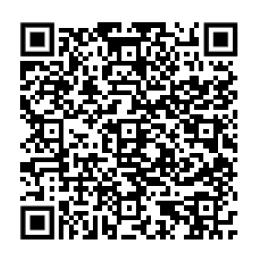
McCarthy Building Companies, Inc. requests bids from qualified contractors for:
Phelps Health Emergency Department Addition Bid Package 2 –Building Controls - Re-bid
The new addition is approximately 80,000 SF and includes a fully fit-out Emergency Department, shelled spaces and support areas.
December 11, 2025 by 2:00 PM CDT
Bid Documents will be available by 11/21/25. All contractors interested in this project must contact Mary Peterein via email at: mpeterein@ mccarthy.com
McCarthy Building Companies, Inc. is proud to be an equal opportunity and affirmative action employer.
McCarthy Building Companies, Inc. 12851 Manchester Road | St. Louis, MO 63131
Momentum Academy is looking to contract with a firm to provide Managed Technology Services. All proposals due no later than December 15th, 2025 @ 12 P.M. Contact Carshaundra Baker, operations@ momentumacademystl. org, for more information.
Bellefontaine Neighbors Recreation Center Boiler Replacement
The City of Bellefontaine Neighbors, MO requests sealed bid proposals for the repair of 54 Bryan tubes for the City Recreation Center’s boiler and also a proposal for a new boiler to replace the existing boiler. Bid forms are available at www. cityofbn.com and can be picked up at city hall 9641 Bellefontaine Rd, St. Louis, MO 63137. Forms should be submitted no later than noon on Monday, December 8, 2025. Attention: Denise Johnson, City Clerk. Questions, contact Marvin Crumer, Parks and Recreation Director mcrumer@cityofbn.com (314) 867-0700.
SERVICE DIRECTORY
Looking to reach more people? We can help you advertise your services. You can email Angelita Houston at ahouston@stlamerican.com or call 314-289-5430
Service: Ground Maintenance, Tree Removal, and Area Clean Up Services
Pre-Bid Meeting Date: December 11, 2025 at 12:30 p.m. Local Time
Question Due Date: December 12, 2025 at 4:30 p.m. Local Time
Bid Due Date: January 5, 2025, 2025 at 2:00 p.m. Local Time
Point of Contact: Delia Cummings –dfcummings@flystl.com
Bid documents may be obtained at St. Louis Lambert International Airport, Airport Properties Division, Monday through Friday between 8:30 a.m. and 4:30 p.m., or by calling (314) 426-8174. This SFB may also be obtained by visiting our website at https://www.flystl.com/ business/contract-opportunities/ Robert Salarano Airport Properties Division Manager
Service: Lindbergh Tunnel Cleaning Services
Pre-Bid Meeting Date: December 2, 2025 at 3:00
Bid
may be obtained at St. Louis Lambert International Airport, Airport Properties Division, Monday through Friday between 8:30 a.m. and 4:30 p.m., or by calling (314) 426-8174. This SFB may also be obtained by visiting our website at https://www.flystl.com/
REQUEST FOR PROPOSALS #: 57825324, Educational Promotional Podcast/Online Education Prevention Curriculum
Harris-Stowe State University (HSSU) is requesting proposals from qualified individuals or organizations to provide the above listed requirement.
If interested, a copy of the request for proposals can be obtained by emailing Barbara A. Morrow at email address: morrowb@hssu.edu and Corey Freeman at freemanc@hssu.edu.
Proposals are due no later than 10:00 a.m. Central Standard Time (CST) on Wednesday, December 10, 2025 and must be emailed to: morrowb@hssu.edu and freemanc@hssu.edu
The University reserves the right to accept or reject any or all responses received, or to cancel this request in part or in its entirety if it is in the best interests of the University to do so. CITY OF ST. LOUIS


“If you’ve ever met Black folks, they are not gonna let a baby starve”
By Rev. Dorothy S. Boulware
Word In Black
A veteran and mother of an 8-year-old, Nikalie Monroe launched her experiment during the government shutdown, when SNAP benefits ran out. One church that showed compassion has received more than $90,000 in donations from around the world.
It was a simple social experiment: a Kentucky TikTokker, posing as an impoverished mom with a hungry, crying newborn, randomly dials houses of worship and records what happens when she asks for infant formula. Her child, she says, hasn’t eaten since the day before, and she’s desperate. For the clergy, it went viral on social media, for all the wrong reasons.
her from the pulpit.
‘Not Gonna Let a Baby Starve’
“Doubling down and pushing out more division and not kind words … not really the route to go,” Monroe, a military veteran and mom to an 8-year-old son, said in one video.
But several of the Black churches and mosques Monroe contacted, by contrast, offered to feed her starving baby — no questions asked.

Rather than follow Christ’s teachings to tend to their flock, both near and far, without question, many of those churches — most of them white — turned Nikalie Monroe down flat, or told her to visit a food bank.
Some megachurches told her to fill out forms or suggested she apply for government aid. While a few churches, after learning they failed Monroe’s test, promised to do better, others shamed
The apparent disparity set social media abuzz.
“This was a white woman calling a historically Black church and a mosque,” @1stliminalspacecowboy, a white TikToker, posted in a response video. “And neither of those places needed to know who she was or what she was like. They were just like, ‘Let me get your information, we’re gonna get you what you need.’”
Meanwhile, the white churches “are means-testing,” the TikToker said, “requiring paperwork and saying ‘come to our church, be a member, your baby and you’ll starve in the meantime, but at least he’ll be one of us.’”
“If you’ve ever met Black folks, they are not gonna let a baby starve,” 1stliminalspacecowboy said.

Churches Put to the Test
Monroe, a drug addiction counselor from Somerset, a small town in southern Kentucky about 80 miles from Lexington, called dozens of churches and temples to test how charitable they are. She began the calls during the government shutdown, around the time that federal anti-hunger programs like SNAP, as well as aid for newborn children and their mothers, had run out of money. If you’ve ever met Black folks, they are not gonna let a baby starve. The videos drew millions of viewers worldwide, sparking social media conversations about

the role of the church in today’s America. But it also put churches themselves to the test under a social media spotlight.
According to a recent Pew Research Center survey 51% of Americans have a positive view of churches and other religious organizations, while 29% have a negative view, and the remainder hold mixed views
While Monroe began the experiment by randomly phoning local churches near her in Kentucky, she soon expanded her survey to churches in other states — including megachurches. Most of them refused, citing paperwork requirements or directing her towards their standard donation process.
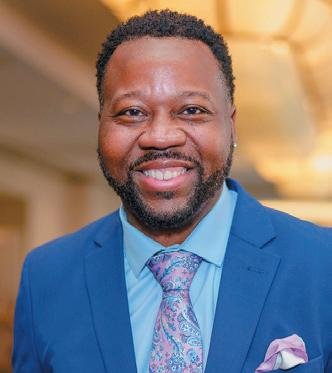
Author’s note: Over the next several weeks, I will focus on an approach I developed called the Triple R Method™, and how to use it to break free from roles, mindsets, and habits that may be holding you back from growth.
Every year you stay in a role that undervalues you, you lose more than a paycheck — you lose confidence, momentum, and sometimes even yourself.
The cost isn’t just financial. It’s emotional, spiritual, and relational. When you accept a role that doesn’t see your worth, you slowly begin to question whether you have any worth.
Did you catch that? The longer you sit in undervaluation, the more likely you are to internalize it. I know that tension well. Early in my career I was passed over for senior roles. When I joined United Way, I felt the capacity for more but was boxed into an entry fundraising role. Not being on the senior team felt like rejection, but the deeper danger was the story it whispered: “Maybe I’m not enough.”
If you’ve ever woken up dreading another day at a job that doesn’t see you, you know this cost. It chips away at your confidence, your drive, even your sense of calling.
Here’s what I learned: undervaluation only holds power when you accept it. And here’s how I broke free — through the Triple R Method™: Reframe, Reclaim, Rename.
1. Reframe Your Thinking When you’re undervalued, the lie creeps in: “Maybe this is all I’m worth.” Your worth doesn’t come from your job title. It comes from your God-given capacity, sharpened through scars and seasons. When I first heard I’d been named CEO, I thought, “They took a risk on me.” A friend reframed it: “You’ve worked hard, and you’ve delivered. This isn’t luck — it’s fruit.”
Your move: Write down the lies your current situation whispers. Then reframe them into truths that reflect your actual capacity.
When a Kentucky woman, posing as the destitute mom of a starving newborn, randomly asks churches to help, a surprising number turned her down flat. But a handful of Black churches agreed to help, no strings attached. They won praise on social media for following Christ’s teachings to feed and clothe the stranger.
Photo courtesy of Pexels
‘Nobody Starves on Our Watch’
In Atlanta, St. Luke’s Episcopal Church sent her call to voicemail. Lakewood Church in Houston — the home pulpit of Pastor Joel Osteen and his faith-based, multimillion-dollar media empire — told Monroe to submit an application for the baby formula, advising her that the process could take days or even weeks. Broadmoor Baptist Church, which initially turned Monroe down, reversed course after its video went viral. Church leaders apologized for the outcome and pledged to do better. And one Appalachian church that eagerly offered to help Monroe is being blessed many times over after its response video went viral. After hearing her plea, Johnny Dunbar, pastor of Heritage Hope Church of God in Somerset, Kentucky, didn’t hesitate: he asked for her information immediately and even offered to get the formula himself.
”Nobody starves on our watch,” said Dunbar, whose kindly demeanor on the call has social media users calling him The Appalachian Grandpa.
Scripture says: “You are fearfully and wonderfully made” (Psalm 139:14). That doesn’t change because someone overlooks you.
2. Reclaim Your Personal Agency When undervalued, it’s tempting to stay quiet, hoping someone will notice. But silence has a cost.
I didn’t wait for someone to hand me authority. I did what was in my control: showing up, learning fast, and refusing to be a lazy learner. That agency — not titles, not domain knowledge — created traction.
Your move: Take one bold action this week to demonstrate your value: speak up in a meeting, propose an idea, or ask for feedback. Don’t wait for validation. Create visibility.
Scripture says: “Faith without works is dead” (James 2:17). Agency means putting hands and feet on your belief.
3. Rename Your Social Networks Sometimes undervaluation persists because you keep listening to the same voices. If the people around you don’t see your worth, you start to believe their version of your story.
I had a friend I spent a lot of time with, but I realized he wasn’t growing the way I needed to grow. If I had stayed in that circle, I would have stayed in that mindset. Quietly, I pulled back.
Your move: Audit your circle. Who reminds you of your worth? Who reinforces your doubt? Spend more time with those who call you higher.
Scripture says: “Do not be misled: ‘Bad company corrupts good character’” (1 Corinthians 15:33).
The Bottom Line The silent cost of staying in a role that undervalues you is steep — capped income, eroded confidence, wasted time. But you don’t have to pay that price. Reframe your thinking. Reclaim your agency. Rename your networks. Do that, and you’ll stop internalizing undervaluation and start stepping into the fullness of your God-given capacity. Reflection Question Where are you silently paying the cost of undervaluation, and what step will you take to break free?
For more, visit OrvinKimbrough.com or MidwestBankCentre.com.